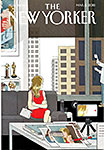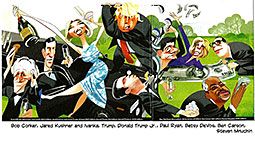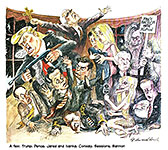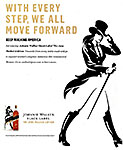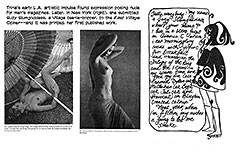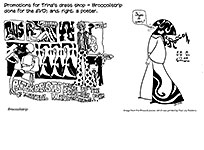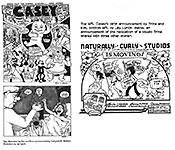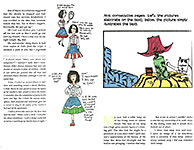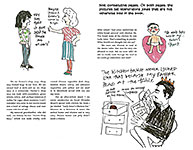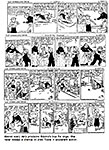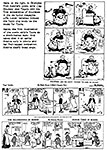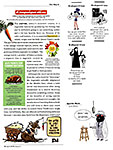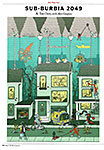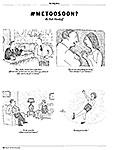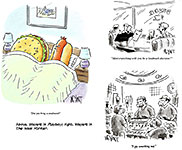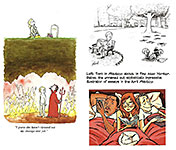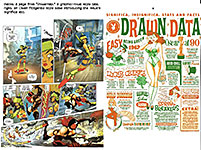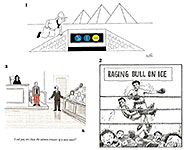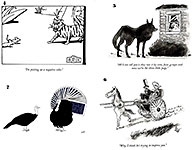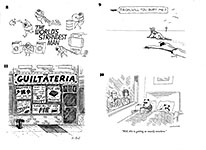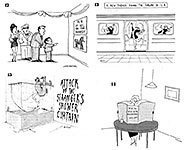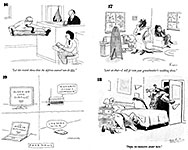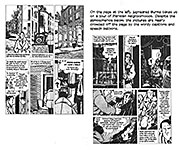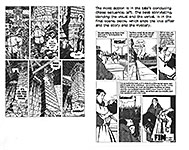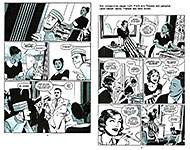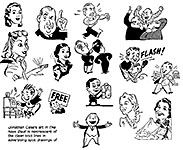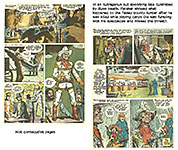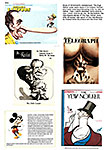 |
||||||||||||||||||||||||||||||||
Opus 377 (completed on April 12, 2008). Another hare-raising monster posting with a report on Stan Lee’s situation (trying to separate rumor from fact), reviews of the first books from a new comic book publisher Sitcomics and of Trina Robbins’ autobiography, Nicole Hollander’s memoir, reprint tome of the classic comic strip Cap Stubbs and Tippie, and graphic novels Fog Over Tolbiac Bridge by Tardi and The New Deal, plus nominees for the NCS Reuben, and reports of “Black Panther” being co-opted by alt-right, Stormy Daniels and Spanky, more about magazine cartooning in Esquire, Playboy and The New Yorker, Playboy’s reaction to sexual harassment, and a ringing statement supporting freedom of the press. In short, it’s another long (and probably tedious) disquisition. To help you find your way to the topics you’re most interested in, here’s a brief listing, in order, by department—:
NOUS R US Is Stan Lee In Trouble? Preyed Upon? Supporting Freedom of the Press Cartoonist in Equatorial Guinea Released Mad Going and Coming Be Heard! Comic for Student Rights Gaiman to Dream Again Coates and Why He’s Writing Captain America The Passing Show: Comic Book Glut A-borning Trump Is a Curse by Mike Thompson, Editoonist Awards Season: Reuben Nominees, Herblock Prize, Nast Award New DC Imprint for High-Profile Stand-Alone Creations Marvel’s New, Too Alt-Right Co-Opts Black Panther Pepe’s Creator Sues Alex Jones Censorship by Another Name
ODDS & ADDENDA Stan Lee Cameos “Black Panther” Record Eagle Scouts
FUNNYBOOK FAN FARE Reviews of Sitcomics “Binge Books”—: Blue Baron, Z-People, Super Suckers, StartUp
EDITOONERY Stormy Daniels and Spanky Delonas’ Racist Editoon An Opinion Page Editor on Editoonery
LECHERY AND THE PENILE PROMPT Playboy and Sexual Harassment
THE FROTH ESTATE Denver Post Dying? Did Stantis Cheat? Or Not?
NEWSPAPER COMICS PAGE VIGIL Taboos Vanquished and Other Events in the Funnies
GOSSIP & GARRULITIES Arming School Teachers
RANCID RAVES GALLERY Chris Ware’s New Yorker Casting Couch Cover Trumpet Caricatures Jane Walker
BOOK MARQUEE More Ernie Books Cartoon County Roz Chast’s Recommended Reading List
BOOK REVIEWS Last Girl Standing (Trina Robbins’ Autobiography) We Ate the Wonder Bread (Nicole Hollander Memoir) Cap Stubbs and Tippie (Edwina’s Comic Strip)
GAG FEST Magazine Cartooning in Esquire, Playboy, The New Yorker
GRAPHIC NOVELS Reviews of—: Fog Over Tolbiac Bridge (Tardi) The New Deal
PASSIN’ THROUGH Michael Fleisher Robert Grossman
FREEDOM OF THE PRESS ENDORSERS
QUOTE OF THE MONTH If Not of A Lifetime “Goddamn it, you’ve got to be kind.”—Kurt Vonnegut
Our Motto: It takes all kinds. Live and let live. Wear glasses if you need ’em. But it’s hard to live by this axiom in the Age of Tea Baggers, so we’ve added another motto:. Seven days without comics makes one weak. (You can’t have too many mottos.)
And our customary reminder: don’t forget to activate the “Bathroom Button” by clicking on the “print friendly version” so you can print off a copy of just this installment for reading later, at your leisure while enthroned. Without further adieu, then, here we go—:
NOUS R US Some of All the News That Gives Us Fits
IS STAN LEE IN TROUBLE? Not only has Stan Lee been sexually harassing his nurses. Or housekeepers. Or whatever they are. He’s also being scammed into penury. Some observers, specifically the Daily Beast reporter, Mark Ebner, sees Lee, the apparent victim of gross financial malfeasance, surrounded by a panoply of Hollywood charlatans and mountebanks, vultures, snakes, leeches, jackals and coyotes, circling around Stan to grab a piece of his fiscal flesh. When Marvel sold to Disney in 2010 for $4 billion, Lee personally pocketed a cool $10 million, but according to some observers (perhaps alarmist ones)—including “one insider with working knowledge of Lee’s current situation”— Lee’s fortune may be gone within a few weeks. “Stan and [his daughter] JC are literally being picked apart by vultures.” We’ve already had a story about his being defrauded of $300,000, then $850,000 while in his dotage; see Opus 375. Oddly, just the other day, I picked up a copy of the National Enquirer (because of a cover story on Trump) and ran across an item on Stan Lee’s supposed predicament. According to the Enquirer, Lee is much more in control than the Daily Beast assumes. “Stan fired his longtime manager, Max Anderson, amid allegations that he may have stolen up to $1.4 million. He also booted sexy nurse Sandra Sanchez, 28, who is accused of conspiring with Anderson to ‘influence’ Stan by giving him naked showers and ‘happy ending’ massages!” And all those stories about Lee sexually harassing his nursing staff? Saith the Enquirer: “Lee told police that staffers have sexually assaulted him and fleeced him of millions!” The same issue of the Enquirer reports that movie actress Terry Hatcher is “homeless and living in a van.” Hatcher has denied any such thing. Moreover, in White House news, the Trumpet administration has been, from the beginning, sabotaged by Obama supporters with the Russia-collusion scam. We can see how much credibility the Enquirer has. Zilch. So is Stan Lee in trouble or not?
THE HOLLYWOOD REPORTER has made a much more detailed report on Lee’s situation, and there are apparently elements of truth in both Enquirer and Daily Beast accounts. Various of Lee’s inner circle have been vying for control of his life and estate (estimated to be worth somewhere between $50 and $70 million). In February, Lee drew up a document about the trust he and his late wife established for their daughter, J.C., now 67 years old. Lee and J.C. have a sometimes contentious relationship, which, for her, revolves around how much money she has to spend. Historically, she spends a lot. The document identifies three men with “bad intentions” who have influenced J.C.—Jerry Olivarez, Keya Morgan, and J.C.’s attorney Kirk Schenck. A fourth person, not named in the document, hovers over Lee and his money—Max Anderson, Lee’s road manager who runs a pop-up Stan Lee Museum at comic cons. Both Olivarez and Anderson have criminal records—as does Morgan although his case is on appeal. Olivarez, a publicist who had insinuated himself into the Lee circle, briefly had power of attorney over Lee after his wife Joanie’s death and committed the $300,000 and $850,000 deals. But Lee has dismissed him. He has also dismissed Anderson, which leaves Morgan working with J.C. to control Lee and his fortune. Saith THR: “Anderson and Olivarez contend that now that J.C. and Morgan [a dubious dealer in memorabilia, chiefly those associated with Marilyn Monroe and Michael Jackson] have established influence over Lee, they will pursue their respective goals: she, unfettered access to her inheritance; he, control over Lee’s intellectual property.” In the midst of this fog are claims of elder abuse and sexual harassment. Some observers say it’s time for Lee to have independent oversight, a conservatorship, that would prevent anyone from leeching money from him. Maybe so. Lee’s 95 and probably not competent to manage a fortune the size of his. You can find the whole THR report at www.hollywoodreporter.com/features/stan-lee-needs-a-hero-elder-abuse-claims-a-battle-aging0marvel-creator-1101229 Some fans who attended the recent Silicon Valley Comic-Con reported being shocked at how tired Lee looked, working all day signing autographs. Well, geez. He’s 95.
IMAGE CO-FOUNDER Todd McFarlane has a different story to tell, which he posted in Instagram. Aware of all the stories swirling around Lee, McFarlane wondered how his old friend (and once editor) was doing. He resolved to find out for himself. On March 29, he visited Lee at his house in the Hollywood Hills and spent an hour with him, bantering and trading “fun stories.” Lee welcomed McFarlane and asked him to sit next to him because his hearing isn’t so good these days. “We talked about things like his growing up in New York,” McFarlane said, “—his love of comics, his even bigger love of his late wife Joanie and how he was doing health-wise. He told me that getting old kind of sucked but said, ‘What are you going to do?’ His stories told me how obvious it was that he missed his wife and, how every day, a pair of ducks come swooping down from the sky to land in his pool and then come up to the glass windows begging for food (which his wife would oblige every time). We talked baseball, movies and he asked what it was it like for me to live next to a giant natural desert preserve in Arizona. “How did Stan look, you may ask? Like a 95-year-old man. I think we tend to forget that fact, at times, since he’s become so iconic and seemingly timeless. He’s a man who has been around for nearly a century. “As I got up to leave, Stan grabbed my hand and said, ‘Todd, thanks for coming by. Your visit is much better than any medicine I could take.’ So, what did I observe on my visit for that one specific hour? I saw a 95-year-old friend. And for me, at least, that was comforting.” And thanks to McFarlane, we are reasonably assured that Stan Lee is not so feeble of mind or body that he can’t protect himself from the vultures around him—regardless of what the Daily Beast thinks.
STATEMENT IN SUPPORT OF FREEDOM OF THE PRESS March 2, 2018 “In the First Amendment, the Founding Fathers gave the free press the protection it must have to fulfill its essential role in our democracy. The press was to serve the governed, not the governors. The Government's power to censor the press was abolished so that the press would remain forever free to censure the government.” —Supreme Court Justice Hugo Black HERE AT RANTS & RAVES, we support and, we hope, champion freedom of the press and endorse the following statement—: As organizations committed to the First Amendment right of freedom of speech and the press, we are alarmed by the efforts of the President and his administration to demonize and marginalize the media and to undermine their ability to inform the public about official actions and policies. Such efforts include the President’s refusal to answer questions posed by a reporter from CNN because the President asserts that the network promotes “fake news”; charges that the media “manipulated” images of the inauguration; false accusations that the media has covered up terrorist attacks; and repeated claims that the media is “failing” and “dishonest.” All of this recently culminated in the President calling the New York Times, CBS, CNN, ABC, and NBC “the enemy of the American People!” and in the exclusion of representatives of various media outlets from a press briefing. In these and other examples, the President and his designees have attempted to villainize and discredit the press for any reporting he dislikes. However, the job of the press is not to please the President but to inform the public, a function that is essential to democracy. The expressions of disdain for the press and its role in democracy by federal officials send a signal to state and local officials. In the aftermath of an election season that witnessed outright intimidation of journalists in communities around the country, there is a compelling need for highly placed federal officials to acknowledge the crucial role of a free press under the Constitution and the responsibility of government officials at all levels to respect it. In one chilling example, multiple individuals who identified themselves as journalists were arrested, detained, and charged with felonies while simply doing their job: reporting on Inauguration Day protests in Washington, D.C. Those arrests were made by local police and pursued by the U.S. Attorney’s Office, both of which displayed an alarming lack of concern for fundamental constitutional rights. The fact that those charges have since been dropped suggests that the arrests were unwarranted and highlights the need for our nation’s leaders to set national policy that unequivocally supports a free and independent press and the public’s right to know. The Constitution enshrines the press as an independent watchdog and bulwark against tyranny and official misconduct. Its function is to monitor and report on the actions of public officials so that the public can hold them accountable. The effort to delegitimize the press undermines democracy, and officials who challenge the value of an independent press or question its legitimacy betray the country’s most cherished values and undercut one of its most significant strengths. The First Amendment protects the right to protest, dissent, and petition government for a redress of grievances, but these rights cannot be exercised without a free press that provides information to the public. Together, these rights represent the constitutionally sanctioned method for the public to oppose government policies and activities and to seek change. The wisdom of this system can be seen in parts of the world where such a right does not exist, or is not honored, and violent opposition is the only available avenue to express opposition or remedy injustice. We condemn in the strongest possible terms all efforts by elected and appointed officials to penalize, delegitimize, or intimidate members of the press. Organizations endorsing the above statement are listed at the end of this Opus.
CARTOONIST IN EQUATORIAL GUINEA RELEASED March 8, 2018; from CBLDF After being falsely imprisoned in Equatorial Guinea for five months and nineteen days, political cartoonist Ramòn Esono Ebalè was finally released on March 7, reported Patricia Mastricolo at Comic Book Legal Defense Fund (CBLDF). It had been just over a week since the one-day trial of Ebalè, where the prosecutor asked for the counterfeiting and forgery charges to be dropped due to lack of evidence, cementing opinion that the charges were fabricated. According to the Sierra Leone Times it was clear that the police officer who had made the accusations used as pretense to imprison Ebalè, had no actual knowledge of Ebalè or of the supposed crime. After offering details to the court that didn’t match the official account, the officer confessed he had simply acted on orders given to him by his superiors, after which the prosecutor had no choice but to recommend the charges be dropped. Angela Quintal, the Africa program director at Committee to Protect Journalists, summarized the feelings of many after Ebalè’s release. “Ramon should never have spent a single day behind bars and we trust that he will not be subjected to any further reprisal.” The positive outcome of Ebalè’s trial is largely due to vigilant news coverage that created constant pressure and accountability, without which Ebalè very easily could have stayed in prison, or been convicted of a crime that not only he didn’t commit, but never even happened. Tutu Alicante, a friend of Ebalè’s and the director of a group that advocates human rights and transparency of rule in Equatorial Guinea, put out an apt call to action: “Ramón’s release from prison is a testament of the power of collective work of dozens of organizations, hundreds of artists and concerned citizens. But we must not forget that dozens of government opponents who are not as fortunate fill Equatorial Guinea’s jails, and that the fight against human rights violations and impunity needs to continue.” Without accountability and international attention, there is little hope others who dissent will fare as well as Ebalè did. Help support CBLDF’s important First Amendment work in 2018 by visiting the Rewards Zone, making a donation, or becoming a member of CBLDF!
MAD GOING AND COMING The last issue of Mad to be produced from New York is No.549; the next issue, No.550, was produced on the West Coast under a new editor. I bought both issues (I usually do not buy Mad) and compared them. The West Coast Mad is not remarkably different from its predecessor. Sergio Aragones is there—with marginals and a 4-page display of themed cartoons. Peter Kuper is there with his usual Spy vs. Spy. Other cartoonists and writers appear to be the Usual Gang of Idiots. Al Jaffee’s famous Fold-In is missing from the New York production, but he’s back with the West Coast issue. In short, the “new” Mad is not noticeably different from the “old” Mad. Perhaps that’s because the “new” Mad published material from its inventory—assembled at its New York digs—which includes, of course, the stalwart artists and writers of yore. The only thing remarkable about the “new” Mad is its cover, which proclaims “Landmark Final Issue” when it is actually the landmark first West Coast issue. It also prints an affectionate good-bye “to all our friends and readers,” and publishes caricatures of 44 of the Usual Gang. In other words, with typical mad perversity, the magazine treats its first West Coast production as if it were its last issue. Which it isn’t. The last New York production’s big feature is the “20 dumbest people, events and things of 2017" with the Trumpet on the cover and also inside, generously. The big feature in the inaugural West Coast issue is Tom Richmond’s visual treatment of Desmond Devlin’s parody of “This Is Us,” which he entitles “This Is Pus.” We conclude with a smattering stuff from both issues.
BE HEARD! A COMIC FOR STUDENT RIGHTS Press Release fsrom Comic Book Legal Defense Fund As millions of American students assert their First Amendment rights in protests across the country, advocacy groups Comic Book Legal Defense Fund and National Coalition Against Censorship have released a new comic book to help protect students' rights. Be Heard! is a free comic by cartoonist Kai Texel that outlines best practices to help kids assert their rights to speech, protest, assembly and petition, warns about risks, and provides resources to get more help. Be Heard! is available as a free download from CBLDF.org & NCAC.org who encourage readers to share it freely. Neil Gaiman, who co-chairs CBLDF's advisory board said: “In the U.S., freedom of speech is paramount. The First Amendment states that you can't be arrested for saying things the government doesn't like. It's important that students everywhere know that they have the right to be heard. This comic will help provide them with practical tools to raise their voice.” Gene Luen Yang, whose distinctions include recognition as a MacArthur Fellow, the fifth National Ambassador for Young People's Literature and author of graphic novels including American Born Chinese says, “A Chinese poet once described free expression as the mother of truth. In our age of fake news, speaking truth to power is more important than ever. This comic is a valuable guide that teaches students how to ensure their truth is heard.” Kai Texel is a New Jersey based cartoonist and illustrator whose clients include Felix the Cat Productions and Dulce Channel. Her art has been published in zines and anthologies such as Our Beloved Monsters. Kai sells her work at comic and anime conventions, and enjoys costume-making on the side. View more of Kai's work athttps://www.kaitexel.com.
GAIMAN TO DREAM AGAIN It’s been 30 years since Neil Gaiman launched The Sandman for DC Comics, observes Christian Holub at ew.com. The title — which followed Dream, the well-named personification of dreams, as he tangled with gods, monsters, and humans while exploring the nature of stories and his own self — ran for eight years, and became one of the defining books of the era. In honor of the series’ 30th anniversary this year, Holub continues, Gaiman is coming back to the Dreaming in a big way. “EW can exclusively announce that DC Comics is launching a Sandman Universe line of four new comic series. The books will be overseen by Gaiman but written and drawn by brand new creative teams. They will pick up story threads and themes from The Sandman while also adding new characters and concepts.” The project kicks off this August with The Sandman Universe one-shot special, which will catch readers up on what’s been happening in Dream’s realm.
COATES AND WHY HE’S WRITING CAPTAIN AMERICA Ta-Nehisi Coates, the author of Between the World and Me, a book about being black in America, will begin writing Captain America for Marvel Comics in July. Coates, a longtime comics fan, began creating them a little more than two years ago with the revival of Black Panther, “reinvigorating the title two years before the movie based on the character became a blockbuster success,” said Jonah Engel Bromwich at nytimes.com. “Coates, who is widely known for his reporting and commentary on race, brought his experience with nonfiction to bear as he was writing Black Panther, taking on politics and culture in the fictional African nation of Wakanda, where the series is set. He challenged the kingdom’s monarchical tradition, introduced an insurgency and questioned the Wakandan religion.” Tackling another national icon in Captain America, Coates wrote an essay explaining “Why I’m Writing Captain America.” Excerpts follow (in italics)—: Two years ago I began taking up the childhood dream of writing comics. To say it is more difficult than it looks is to commit oneself to criminal understatement. Writers don’t write comics so much as they draw them with words. Everything has to be shown, a fact I knew going into the work, but could not truly know until I had actually done it. For two years I’ve lived in the world of Wakanda, writing the title Black Panther. I’ll continue working in that world. This summer, I’m entering a new one—the world of Captain America. ... At the end of World War II, Captain America is frozen in ice and awakens in our time—and this, too, distances him from his country and its ideals. He is “a man out of time,” a walking emblem of greatest-generation propaganda brought to life in this splintered postmodern time. Thus, Captain America is not so much tied to America as it is, but to an America of the imagined past. In one famous scene, flattered by a treacherous general for his “loyalty,” Rogers—grasping the American flag—retorts, “I’m loyal to nothing, General … except the dream.” I confess to having a conflicted history with this kind of proclamation—which is precisely why I am so excited to take on Captain America. I have my share of strong opinions about the world. But one reason why I chose the practice of opinion journalism—which is to say a mix of reporting and opinion—is because understanding how those opinions fit in with the perspectives of others has always been more interesting to me than repeatedly restating my own. Writing is about questions for me—not answers. And Captain America, the embodiment of a kind of Lincolnesque optimism, poses a direct question for me: Why would anyone believe in The Dream? What is exciting here is not some didactic act of putting my words in Captain America’s head, but attempting to put Captain America’s words in my head. What is exciting is the possibility of exploration, of avoiding the repetition of a voice I’ve tired of. And then there is the basic challenge of drawing with words—the fear that accompanies every effort. And the fear is part of the attraction because, if I am honest, the “opinion” part of opinion-journalism is no longer as scary it once was. Reporting—another word for discovery—will always be scary. Opining, less so. And nothing should really scare a writer more than the moment when they are no longer scared. I think it’s then that one might begin to lapse into self-caricature, endlessly repeating the same insights and the same opinions over and over. I’m not convinced I can tell a great Captain America story—which is precisely why I want so bad to try. Coates’ Captain America No.1 drops on the Fourth of July. Excelsior, family.
THE PASSING SHOW The market is glutted again. So many new titles keep appearing that the market cannot sustain them. How many new books disappear after two or three issues? Maybe not lots but enough to suggest that there’s more being produced than fandom can support, even as augmented by an interested move-stimulated general public. But the art is better than ever. The old stalwarts of yore have been replaced by hordes of new artists whose work often appears in but a single title. We’ve never seen them before. How did they get so good at doing comics? Where did they do their apprenticeships? Some of the art is not just competent but spectacular. But that’s often due more to technology than talent. An competent artist with a digital assistant can produce visual wonders.
TRUMP IS A CURSE Speaking as a political cartoonist, the Detroit Free Press’s Mike Thompson sees President Donald Trump is more of a curse than a blessing. He explains—: There's no shortage of news coming from the White House these days, which you'd think would be a goldmine for a guy whose job is to lampoon the folks in charge. But like any megalomaniac, Trump has a way of making everything about him. He sucks the oxygen out of the room and out of any issue he touches. Instead of debating gun control or immigration reform, we end up debating whatever crazy thing Trump just tweeted about gun control or immigration reform, and any potential for movement or change is lost. When all the focus and coverage is on Trump, it's harder to comment on the underlying policies, let alone address important issues that have nothing to do with him and thus generate less coverage than his dumpster fires. I have no desire to draw non-stop about Trump, yet people such as myself need to speak out against the unprecedented manner in which our president is perverting the political process and our institutions.. It's a tough balancing act that, for me, got old real fast. Guess I'm like America — the downside to a Trump presidency far outweighs the upside.
ASIDE From Will Durst on the Trumpet (or, Dopey Donald’s Deign of Error): Maybe he’ll change his mind. Maybe he won’t. Thesre is no way to tell. The man has the integrity of a drunken weasel in a chicken coop. He would rather lie than eat ice cream. And he likes ice cream. He has the same mental capacity God gave a bucket of hair.
AWARDS SEASON
The Reuben. The National Cartoonists Society has nominated five cartoonists as candidates for Cartoonist of the Year; alphabetically—: Lynda Barry, Ernie Pook’s Comeek and various graphic novelish enterprises; Glen Keane, animation; Stephan Pastis, Pearls Before Swine; Hilary B. Price, Rhymes with Orange; and Mark Tatulli, who produces two daily comic strips (!), Lio and Heart of the City. (Tatulli once quipped that as a kid all he wanted to do was draw a comic strip; and now, as an adult, all he does is draw comic strips.) In a departure from its custom, this year two of the nominees—Barry and Keane—are not syndicated comic strip cartooners. Pastis, Price, and Tatulli have all been nominated before, Pastis several times (six? nine?). The winner will be announced at the annual NCS convention, this year on Memorial Day weekend, May 25-27, in Philadelphia, and will receive as token of his/her achievement the Reuben trophy.
Herblock Prize. Ward Sutton has been named the winner of the 2018 Herblock Prize for editorial cartooning. The Prize will be awarded May 9 in a ceremony at the Library of Congress. The Herblock Prize is awarded annually by the Herb Block Foundation for “distinguished examples of editorial cartooning that exemplify the courageous independent standard set by [the legendary Washington Post editoonist] Herblock.” The winner receives a $15,000 after-tax cash prize and a sterling silver Tiffany trophy. Sutton
has been creating biting editorial cartoons for the Boston Globe since
2008, but his cartooning is not confined to the newspaper, and even in the Globe,
he wanders from editooning traditions. He experiments with size and format,
often producing multi-panel cartoons that can read like a graphic novel. In
2010, his full-page “Tea Party Comics” won a gold medal from the Society of
Publication Designers. Sutton has also created cartoons for The New Yorker, Village Voice, New York Times, The Nib, In These Times, GQ, The Nation, Time, TV Guide, Rolling Stone, Fusion, MAD Magazine, and many more. But the best known of his work appears in the satirical weekly The Onion: since 2006, Sutton has semi-secretly been the man behind Stan Kelly, the (fake) editorial cartoonist for the weekly. His book, Kelly: The Cartoonist America Turns To (TM) was published in 2016 (and reviewed here in Opus 358). Stephen Colbert has said: “Ward Sutton’s satire doesn’t just bite, it maims. He’s the perfect cartoonist for our discordant times.’’ Alarmed by the incoming Trump administration, Sutton drew a “RESIST” poster image and distributed it for free online in 2017. It was downloaded, printed, carried in marches all over the world, and later chosen by American Illustration in its annual competition. In addition to cartooning, Sutton has created posters for Broadway, the Sundance Film Festival, and musicians such as Beck, Radiohead, Phish, and Pearl Jam. He has designed, directed and/or produced animation for HBO, Noggin and Comedy Central. His work has been recognized by the Society of Illustrators, American Illustration, the Society of Publication Designers, the Society for News Design, the Minnesota Page One Awards and the Art Directors Club. Sutton Impact: The Political Cartoons of Ward Sutton was published in 2005. Judges for this year’s contest included another unconventional cartoonist who won last year’s Herblock Prize, Ruben Bolling, author of the weekly comic strip Tom the Dancing Bug; Jenny Robb, Curator of the Billy Ireland Cartoon Library & Museum at Ohio State University; and Ann Telnaes, editorial cartoonist for he Washington Post and first woman to have received both the Reuben Award and the Pulitzer Prize for Editorial Cartooning. The judges said: “We were greatly impressed by the quality and breadth of submissions, with so much outstanding work being done in all types of political cartooning. But we felt that Ward Sutton's combination of strong artwork and sharp satirical writing stood out. Ward's art style has an appealing comic book look that includes a mastery of caricature within that context. He juxtaposes these attractive drawings with strong, urgent writing, setting up creative premises and wringing out of them cutting humor and provocative commentary that rise to the historical importance of today's issues.” Steve Brodner, a satirical illustrator who has covered nine national political conventions for Esquire, The Progressive, The Village Voice and others, was named this year’s finalist and will receive a $5,000 after-tax cash prize. The judges said: “Strong caricatures in editorial cartoons convey vital information to the reader about the character and motivation of a political figure. Steve Brodner's superior draftsmanship and effective use of caricature in his editorial commentary was well-represented in his portfolio and is exemplary of the high quality artwork of Herb Block and other legendary cartoonists.” The Herb Block Foundation seeks to further the recognition and support of editorial cartooning: www.HerbblockFoundation.org.
Thomas Nast Award. Editoonist Clay Bennett has won the 2018 Thomas Nast Award for the best cartoons on international affairs. The award is presented by the the Overseas Press Club of America.
"I feel very honored, if not a little out of place, to be included in such a distinguished group of journalists" Bennett said. "Maybe I'll seem more respectable, if only by association." This is Bennett's third Thomas Nast Award. He's also received the Sigma Delta Chi Award, the Robert F. Kennedy Journalism Award and the National Headliner Award. Bennett, who won the Pulitzer Prize in 2002, has been a finalist for the prestigious honor a record seven times.
DC’s IMPRINT FOR HIGH PROFILE STAND-ALONE STORIES DC has unveiled the Black Label imprint as a place for high profile stand-alone stories from top talent, stories that take place outside the continuity of the DC Universe. Like Watchmen, Batman: The Killing Joke, and DC: The New Frontier, reported Nicole Bunge at ICv2, Black Label stories will feature top DC characters crafted by creators like Frank Miller, Kelly Sue DeConnick, Scott Snyder, Brian Azzarello, John Ridley, and Greg Rucka. “Many of our perennially best-selling, critically acclaimed books were produced when we unleashed our top talent on stand-alone, often out-of-continuity projects featuring our most iconic characters, a prime example being Miller’s The Dark Knight Returns,” said DC Entertainment co-publisher Jim Lee in a statement. “Creating DC Black Label doubles down on our commitment to working with all-star talent and trusting them to tell epic, moving stories that only they can tell with the highest levels of creative freedom.” Each of the DC Black Label titles will be released in a format and on a schedule dictated by its creators and will take place outside of the canonical DC Universe as seen in regular comic book titles, allowing creators to take full advantage of the creative possibilities on offer. The first of the Black Label books will be a three-part Superman: Year One by Frank Miller and John Romita Jr., to be launched in August. “A groundbreaking, definitive treatment of Superman’s classic origin story in honor of his 80th anniversary. This story details new revelations that reframe the Man of Steel’s most famous milestones — from Kal-El’s frantic exile from Krypton, to Clark Kent’s childhood in Kansas, to his inevitable rise to become the most powerful and inspiring superhero of all time.” Also announced for the label are Wonder Woman Historica: The Amazons, written by Kelly Sue DeConnick, her first major work for DC, with art by Phil Jimenez; John Ridley’s previously announced The Other History of the DC Universe; Batman: Last Knight on Earth by Scott Snyder and Greg Capullo; Batman: Damned by Brian Azzarello and Lee Bermejo; and Wonder Woman: Diana’s Daughter (working title) by Greg Rucka.
MARVEL’S NEW, TOO Not to be outdone by DC, Marvel joins the competition by proclaiming “newness” wherever we look. In the March Previews, Editor-in-Chief C.B. Cebulski headlines his pitch “New Creative Teams, New Series, New Directions, New Beginnings.” He continues: “When I think about what’s next for us and our fans, these are the four things that come to mind.” “Infinity Countdown” is apparently the heading under which several new directions will commence. And then there’s the “Hunt for Wolverine” and another new beginning for Black Panther, who is apparently going off into space. Or, at least, “across the vast Multiverse wherein lies an empire founded in T’Challa’s name.” Says Black Panther writer Ta-Nehisi Coates: “I’m really excited about this new saga for T’Challa. I feel like it will ultimately serve to complete the journey he began in the last volume.” Coming to comics authorship only a year or so ago, Coates finds that his comfort level has evolved. “It’s still a challenge,” he says, “and
honestly, may it always be so. But I certainly feel more comfortable with T’Challa’s ‘voice’ and with the ‘voices’ of his supporting cast.” And then there are numerous round-number anniversary issues—Amazing Spider-Man No.800, Invincible Iron Man No.600, Deadpool No.300. (Three hundred of this character already?!) In the Marvel Preview, an insane Todd Nauck produced a two-page spread depicting a few hundred Marvel characters; and then Scott Koblish did another equally insane jam of Deadpool as a wraparound cover for No.300. We’ve posted them near here, too tiny to see, of course—but they are tiny in the original publication, too. Just enlarge these images to “read” them.
ALT-RIGHT CO-OPTS BLACK PANTHER By Craig Timberg, Drew Harwell and Steven Zeitchik Washington Post, March 15, 2018 White nationalists have embraced "Black Panther," Marvel Comics' blockbuster movie, to push their argument online that nation-states should be organized by ethnic groups, according to new research published Wednesday, an unlikely convolution of the ground-breaking African superhero movie. One popular image circulating on far-right corners of the Internet shows the title character — the superhero king of the fictional, secluded and wealthy African nation of Wakanda — wearing a red “Make Wakanda Great Again” hat, explicit homage to President Trump’s “Make America Great Again” campaign gear. The image, first posted online in June, months before the Disney/Marvel film's February release, carried a headline of “BLACK PANTHER IS ALT-RIGHT,” referring to the movement that espouses racist, anti-Semitic and sexist views and seeks a whites-only state. It claimed the superhero opposed immigration, diversity and democracy while favoring “ethno-nationalism” — a profound mischaracterization of the movie’s main themes, according to researchers at Data & Society, a New York-based think tank that studied far-right online conversation about the film. They said the film uses science fiction and "Afro-futurism," a thematic exploration of African and African American history, to explore real-life questions of culture, race and politics. RCH: The alt-right and its coterie of white supremacists are so intellectually impoverished that they steal from others and pervert their intent. They have no shame, of course—as is amply exemplified in their wrong-headed beliefs and execrable pronouncements.
PEPE’S CREATOR SUES ALEX JONES Artist Matt Furie is suing Alex Jones’s crazed conspiracy theory website for copyright infringement over an item for sale in the site’s online store, a poster that features an image of Pepe the Frog alongside figures the site champions, including Donald Trump, Milo Yiannopoulos, Roger Stone, Matt Drudge, Kellyanne Conway, and Jones himself, reports Benjamin Sutton at hyperallergic.com. The poster is emblazoned with the acronym MAGA, for Trump’s campaign slogan, “Make America Great Again.” The poster’s design is attributed to “artist and patriot Jon Allen” and priced at $29.95. “The guiding principle for the enforcement of Matt’s rights is that Matt does not want people to profit from sales of images and merchandise that use Pepe the Frog in connections with ideas or symbols of hate,” said Louis W. Tompros, one of Furie’s attorneys. “What we want is for Infowars to stop selling this poster and turn over any profits from past sales of it.” InfoWars owner Alex Jones has issued a series of statements in response to the lawsuit brought by Furie, calling it “fraudulent” and suggesting that he has no valid claim to the image of Pepe the Frog. Jones vows that he will fight Furie’s lawsuit.
CENSORSHIP BY ANOTHER NAME Since 2010, the Massachusetts Independent Comics Expo has featured exhibitor spaces with the names Bechdel Room, Crumb Room, Doucet Hall, and Eisner Level as a “fun way” to pay tribute to influential cartoonists. This year, writes Dan Mazur, co-director of MICE, they’re retiring Crumb’s name. The reason? Quivering pusillanimity in the face of imagined public opinion. Because some of Crumb’s comics offer images or narratives of racial stereotypes and sexual violence that are likely to impact offensively “those whose voices have not been historically respected or accommodated during the period in which Crumb has [otherwise] so effectively challenged and shattered many cultural taboos. “The great value of Crumb’s radical and inventive freedom of expression is, we acknowledge, seriously problematic because of the pain and harm caused by [such imagery]. The simple appellation, ‘Crumb Room,’ without context or opportunity for dialogue, can function more as an insult to those we want to feel welcome and respected than as a fitting homage to an artist.” There will always be people who take umbrage at something. To quote Sarah Boxer in The Atlantic: “Must we listen to everyone who’s offended? Or only to those we agree with? Or only to those in power? Or only to those without power? Or only to those willing to kill for their beliefs?” Perhaps instead of quivering, MICE should fulfill one of its implicit purposes and use the opportunity of the Crumb Room to provide context for the homage to Crumb. The Crumb Room offers a teachable moment. Why not take advantage of it?
ODDS & ADDENDA The March 16/23 issue of Entertainment Weakly devotes 40 pages to the Marvel Cinematic Universe, plugging the forthcoming “Avengers: Infinity War” but
also attempting, with articles, graphs and charts, to explain the MCU. Lots of vital information for anyone who wants to understand it all. There’s a special sidebar showing Stan Lee’s cameos in 14 of the flicks and a two-page spread showing the relationships of all the characters to each other. Massive. ◆ “Black Panther” is the first movie since “Avatar” to top the domestic box office five weeks in a row, pulling in over $605 million in just 31 days. ◆ The world needs more Eagle Scouts, and 2017 delivered in a big way. Exactly 55,494 young men became Eagle Scouts last year. That’s the most in a single year since 2013, and it’s the fourth-biggest Eagle Scout class in history (trailing 2012, 2010 and 2013). This is good news for our country and our world. It means the planet has another 55,494 people who are prepared to be outstanding friends and coworkers, leaders and innovators, husbands and fathers.
Fascinating Footnit. Much of the news retailed in the foregoing segment is culled from articles indexed at https://www.facebook.com/comicsresearchbibliography/, and eventually compiled into the Comics Research Bibliography, by Michael Rhode, which covers comic books, comic strips, animation, caricature, cartoons, bandes dessinees and related topics. It also provides links to numerous other sites that delve deeply into cartooning topics. For even more comics news, consult these four other sites: Mark Evanier’s povonline.com, Alan Gardner’s DailyCartoonist.com, Tom Spurgeon’s comicsreporter.com, and Michael Cavna at voices.washingtonpost.com/comic-riffs . For delving into the history of our beloved medium, you can’t go wrong by visiting Allan Holtz’s strippersguide.blogspot.com, where Allan regularly posts rare findings from his forays into the vast reaches of newspaper microfilm files hither and yon.
FURTHER ADO I wonder how much support I’d get if I were elected a town clerk but refused to issue gun licenses because guns are against my religion.—Benjamin L. Corey
FUNNYBOOK FAN FARE Four-color Frolics An admirable first issue must, above all else, contain such matter as will compel a reader to buy the second issue. At the same time, while provoking curiosity through mysteriousness, a good first issue must avoid being so mysterious as to be cryptic or incomprehensible. And, thirdly, it should introduce the title’s principals, preferably in a way that makes us care about them. Fourth, a first issue should include a complete “episode”—that is, something should happen, a crisis of some kind, which is resolved by the end of the issue, without, at the same time, detracting from the cliffhanger aspect of the effort that will compel us to buy the next issue. A completed episode displays decisive action or attitude, telling us that the book’s creators can manage their medium.
SINCE WE LAST MET, my packet of “Binge Books” arrived. Four titles—Blue Baron, Startup, Super Suckers, and Z-People. The term “Binge Books” conjures up “binge drinking”—drinking to excess; you can “pig out” on one of these books because each one is three times as long as the regular breed—and still just $3.99 each. Written and produced by one guy, Darin Henry, a former tv sitcom writer (“Seinfeld,” “The War at Home,” “KC Undercovser”) publishing his comic books under the name Sitcomics, all the books, regardless of genre, are “comedy.” In short, they’re all sitcoms. The comedy of a couple of the books is apparent from the covers of the titles. Super Suckers is about a college sorority girl who becomes a vampire (her biggest problem is that, because her image no longer shows up in mirrors, she can’t apply make-up properly). Z-People is about a zombie infestation that drives people into hilarious panic. The other two of the company’s first productions are superhero comics, but each operates within a ridiculous concept. In Blue Baron, a 300-year-old superhero accidentally exchanges bodies with a 20th century teenager, and neither knows how to act. Comedy ensues. In Startup, a 300-pound single mother loses weight and magically becomes a superheroine. Comedy ensues some more.
Henry
is so accustomed to writing sitcoms for television that he breaks into his
comic book narrative for commercials. And the commercials, of course, are
humorous. One of them, posted near here, is for Sleep With Me mattresses; the
product name, as you can see, gives rise to all sorts of suggestive hilarity. And the advertising pages are introduced with typical tv lingo: on the last panel of the preceding page we’re told that the narrative will resume “after this message from our sponsor.” Aside from these commercial breaks, each of the Binge Books tells a complete stand-alone story. Nothing—except the cast and the concept—is continued into the next issue. Hence, an aspect of our criteria for evaluating the first issue of a new comic book title is rendered invalid: none of the Binge Books end with cliffhangers designed to create suspense that only reading (and buying) the next issue can relieve. All that’s left to evaluate an inaugural issue is whether the characters are likeable. And that’s pretty much an idiosyncratic matter of personal preference. All of Henry’s books contain at least one episode that gives us insight into the personalities of the characters. And all of the Sitcomics characters are likeable. For that reason alone, then, we’re likely to return for more in subsequent issues. All four titles are expertly drawn. And the storytelling—panel composition, narrative breakdown, page layout for dramatic impact—is masterful. No surprise: the artists are veterans in the funnybook biz.
Z-PEOPLE IS DRAWN by Tom Richmond of Mad magazine. But in this title, no movie celebrities are cast, so Richmond’s ability as a caricaturist is not on display. On display is the sort of general panic felt by most of the characters at the impending danger of being eaten by a zombie. The cast members are the crew of a television news program, and a lot of the jokes are therefore inside jokes. Annie Livingston is a self-centered “star” reporter more concerned about her appearance than news facts. Another female of the crew has the hots for one of the guys and is continually hinting that they could get it on together. One of the crew, Brody, is half-infected: he looks like a zombie but hasn’t gone all the way over to living death and an appetite for brains.
The issue ends with everyone taking time out from their individual pursuits to have a party. Apart from the ennui induced by the over-all prevailing panic—people all the time screaming and running off— the other off-putting aspect of this title is that all the “survivors” (as the tv crew is termed) must wear a green goo on their faces in order to ward off zombie attacks. The green splotches throughout are a thoroughly unappetizing aspect of the visual storytelling.
BLUE BARON confused me for a while. This was the first title I read, and I thought it was supposed to be serious superheroing. It took half the first issue before I finally realized that it, like all the other titles, was a sitcom. The Baron and his Heroes Union sidekicks battle Team Toxic, whose team members have odd names—Wet, Gross, Loophole. Names keep cropping up like weeds with no referents—Mikado, Liquidator, Takeover, Maven, Ticker. Meanwhile, another story is taking place at a modern American high school where Ernesto Rodriguez, Ernie, a likeable kid with biracial parents, is opposed by a bully named Kevin Slater. Then all of a sudden, the Baron and Ernie accidentally exchange bodies. Henceforth, the Baron behaves like an American teenager, and Ernie, inhabited now by the personality of the Baron, lacks the physical wherewithal to perform as he (i.e., the Baron) is accustomed to in fighting evil. So he talks like a hero but can’t perform. Confusing. There’s lots of fighting, usually without much justification. The motive for bad guys attacking the good guys is that bad guys hate good guys. That’s the satirical thrust of all the hostilities.
The first issue concludes with the Baron and Ernie making a pact to act in concert somehow. In the second issue, Ernie manages to put Slater down and attracts a girlfriend. And at Heroes Union, some of the Blue Baron’s sidekicks begin to suspect that something’s wrong with him; after all, there’s a teenager inside the big man’s heroic bulk. And sometimes, it shows. Ron Frenz, a Marvel vet who co-created Spider-Girl with Tom DeFalco, penciled the book; Sal Buscema, another Marvel minion known for his 10-year run on the Hulk, did the inking. Expertly done by both.
SUPER SUCKERS is drawn by Jeff Shultz, who’s worked on Archie books for some years (credited on at least a couple hundred), and Super Suckers looks like an Archie book. The heroine, Kelly Kellogg, could be a blonde Veronica. And the entire book is infused with the manic excitement of adolescence even though its cast is composed of college students; Kelly is a sorority girl, which may account for her silliness. After an introductory footnote that “Super Suckers was drawn in front of a live studio audience” (just a little joke left over from Henry’s tv career), the narrative opens with Kelly being dumped by her erstwhile boyfriend, Dragos, an foreign exchange student who’s going back to his country. Soon thereafter, Kelly discovers she’s a vampire: she can’t see herself in the mirror, and she has fangs. She discovers this when she meets Jess, who has also been dating Dragos. Jess has been infected, too. They conclude that Dragos is a vampire and has turned them both into blood suckers. The narrative’s background is a blood drive being conducted by Kelly’s sorority. All of a sudden, blood has a special meaning for Kelly and Jess. They meet Stewart, a buddy of Dragos, and Stewart sells his own blood—sometimes to Dragos. Right: he’s a blood donor. He is otherwise famous on campus for peeing in his pants in biology class. He’s a “whiz” in biology, quips Kelly. (That’s the kind of sitcom humor that flourishes in Henry’s Sitcomics books.) They also encounter a vampire slayer, Richard, who is so hot they both fall all over themselves to attract his attention. He wants to protect Kelly, and Kelly would love to be protected: “Oh, yes—Richard,” she pants, “—please, protect my brains out.” The syntax here and elsewhere in this title echoes other familiar utterances, in this case, “fuck my brains out.” (But you knew that, right?) The sorority has a big blood drive party, but the plan goes awry: all the blood donors are a little drunk, so the blood they donate is alcoholic, which renders the blood unusable. Useless for its intended purpose, the alcoholic blood is a perfect party drink for Kelly and Jess. Jess has a roommate, Vera Hodge, who is a gigantic fat African American. The casting here is a little unfortunate: an African American woman who is fat falls into a racial stereotype that most African Americans want to avoid. Otherwise, Vera is a force of nature, commanding everyone around her. After showering, she stands naked in front of a window to “air dry,” a process that attracts the wrapt attention of male neighbors. Of course. This is the book that asks the question: how much comedy can you wring out of two female vampires, a hot male vampire slayer, a blood drive and a blood donor. The answer: a carload lot of asinine zanity.
STARTUP, the fourth Sitcomics title, comes dreadfully close to being a serious superhero story. A Latina mother named Renee is seriously overweight—about 300-pounds worth—but she runs into a doctor with a 6-minute reduction diet. She drinks his elixir, and suddenly, she’s a svelte beautiful woman. And she’s immediately thrown into superheroing. The good doctor, it seems, has borrowed money from a criminal element to finance his experiments, and the “collection agent” suddenly shows up and demands his money. When he attacks the doctor, Renee leaps to his defense—and discovers that she’s not only svelte but superpowered. The doctor, however, dies anyhow (a sure sign of seriousness). When Renee gets home after this battle, she explains to her 12-year-old son Malcolm that she maintains her slender self by concentrating; when she fails to concentrate, she’s fat again. “It gets even crazier,” she goes on. “When I squeeze down to my smaller size, all that squeezing creates an energy that gives me super speed.” Malcolm quickly realizes that his mother can join the Heroes Union (in which the Blue Baron operates as the leader), and he sets about to design a costume for her. And Renee comes up with a nom de guerre. Since she’s just starting up as a superhero, Startup is her name. She then proves her super-ness by vanquishing another bad actor. Meanwhile, yet another bad guy kidnaps her son in order to get Startup to stop superheroing. But she keeps on and rescues her son. Renee
almost gives up the superheroing game: her participation in it, after all,
endangered her son. Malcolm convinces her not to waste her It all fits handily and just a little satirically into the familiar superhero mold. This is the best of the four titles, I’d say. And it’s also beautifully drawn by Craig Rousseau, a 46-year-old artist who has worked for both Marvel and DC, with the latter, Harley Quinn and Batman Beyond and others. Recently, he drew Spider-Man Loves Mary Jane for Marvel. He’s also done work for Disney and Image. In Startup, he deploys a sinuous line that waxes and wanes, and when it waxes, it often splits into two parallel lines, an intriguing and attractive visual novelty.
WITHOUT THE CONTINUING STORY’s cliffhangers to seduce us into picking up the next issues of these titles, the only thing to bring us back is whether we like the books or not. If you like sitcoms with a giggle on every page, you’ll like these books. I’m tempted to say that all the snickering undercuts the story a little; but then, except in Startup, the stories are merely vehicles for telling jokes so we can’t complain. Apart from comedy, the other appeal of the books must be the characters. Do we like them? Blue Baron is a trifle too fatuous to be altogether likeable for me (although I like the drawing a lot); in Z-People, only one of the ensemble is at all likeable—but he’s not very distinctive; Super Suckers is all adolescent goofiness conducted at a rip-snorting rate. Only Startup’s Renee is throughly likeable. And there aren’t many jokes in this title, comparatively speaking. My chief criticism—and this, the publisher could scarcely have anticipated—is that these 64-page books that you can “binge read” in are too long! I’ve become habituated to today’s brutally short books, and in reading these loooooooooong ones, I soon begin to yearn for them to stop. Ironic. But then, we all know that sitcoms are all half-hour programs. Nobody makes a sitcom that can last an hour. Except Darin Henry.
QUOTES & MOTS Sean Penn in Time on #MeToo: “I have hopes that it moves more into baby steps because I want it to win. I fear that when groupthink becomes a media legislation of free speech and a social-media jury to convict anyone, it is no longer an American process, which is due process. The greater issue is that there are very serious changes that society needs to make to improve life for women, for homosexuals, for immigrants.” On divisiveness and political polarities: “We’ve got to be a ‘we’ at some point. Once good intentions start forcing everybody into camps, the strategy is off. And then things get worse. If people take some kind of high ground, like only Danish princes can play Hamlet, then we’ve lost the joy of life.”
EDITOONERY The Mock in Democracy WE’RE GOING TO POSTPONE a thorough review of the past month’s editorial cartoons because this posting is already bursting at the seams. We’ll devote all our energies next time to analyzing a gigantic wad of them. That’ll come along in a week or so. But we’re reluctant to abandon our star player in this department—the ever-bloviating Trumpet, comedian-in-chief of the nation’s capital. So we’re posting a couple of the latest caricatures in the Rancid Raves Gallery down the scroll. Meanwhile, here amid the wreckage, we’ll focus on only one of the Trumpet’s star turns—namely, his canoodling with Stormy Daniels. We choose this topic because the national news is otherwise so desperately serious, and Stormy offers a welcome respite from all that grim gasbaggery. Besides, focusing on Stormy permits us to display an array of photographs of a barenekkidwoman with giant hooters, always a delightful occasion. The photos deliver the titillation promised in the titillating news of the now-celebrated dalliance. But first, the editoons. At
the upper left of the display, Steve Sack’s picture gives the words
“Presidential Seal” a new meaning. I confess that I picked the Bagley cartoon because of the drawings of the Trumpet and Stormy—not because of the comment it offers on the Evangelicals witnessing the spanking. But that comment seems so nicely achieved that it’s worth examining. Although Evangelicals who are concerned about End Times might be assumed to disapprove of the Trumpet’s sexual adventures, here they seem to be making excuses for his behavior. And that’s Bagley’s point: Evangelicals are so hypocritical that they will twist their religious convictions out of shape in order to avoid criticizing Trump for his obvious moral transgressions. Adam Zyglis at the lower right continues an assault on the super religious Evangelicals by examining another kind of “hush money” that the Stormy incident has revealed. Why are the rabidly religious Evangelicals still supporting the Trumpet, the present-day incarnation of moral depravity that they ought to be noisily denouncing? It’s because Spanky has promised to give them federal judges of right-wing rectitude akin to their religious guise. And finally, Phil Hands explains why the Trumpet’s touted Base is sticking with him. For them, having sex with a porn star is a towering achievement. Hands doesn’t need two panels to express this view—the second by itself carries the essential message; but two panels permits him to offer a vivid contrast that makes his point more dramatically. Next, we have a gallery of Stormy’s various splendors.
It seems to me that her hooters vary somewhat in size, as if in the more recent of the photos they’re bigger than in the older photos. But that could be a simple optical delusion. You can find hundreds of naked Stormy photos on the Web; just type the name in your browser. We’ve concluded the second Stormy exhibit with a cartoon from Daryl Cagle in which Spanky, glorying in Stormy’s pillowy pontoons, is saying “Nothing to see here,” a statement of delightful irony, addressing, as it does, both the picture before us and the Trumpet’s hopes for his Stormy adventure. About this cartoon, Cagle writes: “I thought it would be a funny caricature to chop off most of her face because it is her big, pointy chin and thin, straight lips that are distinctive. I could have done the caricature with no face at all since her colossal boobs are all she needs for a caricature. I’ve noticed that other cartoonists give Stormy a breast reduction in their drawings—an unusual situation for cartoonists who typically exaggerate features. I also liked the idea of a composition where the top/right half of the image is empty.” Cagle’s caricature of Spanky with only half of his face visible is masterful. And with that, we’ll close this posting’s seminar on the arts of editoonery, and take up the topic from another point of view—namely, the editors’ perspective in choosing and publishing editorial cartoons.
Delonas’ Racist Editoon At the elbow of
your eye, we’ve posted a cartoon by Sean Delonas that raised hackles and
ire from coast to coast in early February when it was posted. The white guy’s comment makes Delonas’ message clear: the robbers are “Dreamers,” the guy says, —“or future Democrats,” a small-print elaboration that explains the conservative interpretation of Bronco Bama’s DACA effort. It’s all an insidious plan to benefit the Democrats. While the cartoon is offensive enough to readers who are not deep-dyed Trumpists, it is doubly so to Hispanics—all of which seems to have been lost on the editors of the Albuquerque Journal, which published the cartoon on February 7, in apparently blissful ignorance that New Mexico has a large Hispanic population. The cartoon inspired a good deal protest wherever it was published, but at the Albuquerque Journal, even the protest seems to have soared over the heads of the paper’s editors. The editor-in-chief, Karen Moses, attempted to explain: “Political cartoons are often satire and poke at more than one point of view. I do not presume to know what cartoonist Sean Delonas was trying to convey in this cartoon published in yesterday’s paper. But on one level it appeared to us to be poking at President Trump’s rhetoric by portraying a quaking Republican couple who were painting Dreamers with a broad, totally false, brush. “In hindsight,” she went on, obliviously, “instead of generating debate this cartoon only inflamed emotions. This was not the intent, and for that, the Journal apologizes. I repeat that the Journal does not condone racism or bigotry in any form.” And she concluded even more blindly: “I also want to reiterate that we do not agree with many of the opinions expressed on the editorial pages, which are intended to encourage debate.”
GIVEN THE SEEMING LOGIC behind Moses’ remarks, it’s easy to see how the paper managed to publish such an inflammatory message. Political cartoons are not “often satire”: they’re almost always satire. But Moses “does not presume to know” what this cartoon is about. Yes, by the most convoluted of intellectual contortions, the cartoon could be viewed as ridiculing the Trumpet’s opinion. In that interpretation, the cartoon is sarcastic, and not much more. And sarcasm, as I’ve said here several times, is a risky mode of satire. In
sarcasm, you must assume the attitude you’re criticizing, which often leads a
viewer to assume you share that attitude (when you are actually opposed to it).
The most celebrated instance lately of sarcasm gone awry in this fashion is the Barry Blitt cover of The New Yorker after the election of Obama,
which shows the new Prez and his wife in extremist Muslim garb fist-bumping in
triumph as if they have overthrown the government. With Moses’ admitted incompetence at understanding editoons, it’s easy to see how she could have misunderstood Delonas’ message. What’s astonishing, however, is that Moses publishes things on her editorial page that she doesn’t understand. But, even more astounding, Moses is not alone. Editorial page editor D’Val Westphal is quoted in the Journal’s response to reader protest as saying “she chose to run the cartoon because she interpreted it as criticizing fear of immigrants and the broad-stroke racism of calling all Dreamers criminals.” But, the article continues, “nearly all of the hundreds of readers who called and commented on the cartoon saw it as anti-immigrant and racist. “‘It labeled our Dreamers as criminals,’ said protester Margarita Maestas, a retired educator who walked into the Journal to cancel her 17-year subscription” before joining the protesters outside the building. And she wasn’t alone. The paper lost hundreds of subscriptions in just hours.
THE JOURNAL’S EDITORS, obviously lost at sea, even contacted Delonas about his cartoon. The paper reported (with numbing obliviousness) that the cartoonist said “the protesters and angry commenters were more accurate in their interpretation of his cartoon than Westphal. He said he believes that unchecked illegal immigration has a negative impact on public safety and wages. “‘I’m not saying they can’t come in; they have to come in legally, and they have to be vetted,’ Delonas said. ‘I think you can call them Dreamers, but I kind of agree with Trump that Americans have Dreams, too.’” Several of the state’s leading politicians, including the state attorney general, issued a joint statement, calling the publication of the cartoon counterproductive to current negotiations on immigration reform. “Instead of putting aside the vitriol, this cartoon feeds it. It plays to the most false and negative stereotype of Dreamers, which can only serve to enrage extremists. ... It’s never the right time to refer to a group of nearly 800,000 people as criminals, especially when they are active members of our communities, including military service members, teachers, doctors, business owners and more.” Moses denied that the cartoon, as understood by legions of protesters, represented the position of the newspaper. But she also persisted in saying that “we do not agree with many of the opinions expressed on the editorial pages” of the paper. As policy, this seems idiotic. But what she doesn’t do is connect that idiotic statement to the over-all purpose of the editorial page—which, she says, aims to encourage debate. If that’s its only purpose, it doesn’t matter much what the paper publishes on its editorial pages. Even more reckless is the paper’s apparent policy in selecting editoons to print. In an seeming effort to be evenhanded, it publishes a conservative cartoon every other day, and on alternate days, a liberal one. Conservative one day, liberal the next. The day before publishing the Delonas cartoon, the Journal published a cartoon critical of the Trumpet. The Albuquerque Journal —alas, like many newspapers—seems to regard editorial cartoons as simply “visuals,” decorations, that break up the gray matter on the editorial page. They make the page look more attractive. But that’s not all. As the outcry over Delonas’ cartoon proves, editorial cartoons are powerful statements of opinion. They are viewed by thousands of readers, whose opinions are either changed or, more likely, confirmed by what they see. In either case, they’re engaged. The Albuquerque Journal would be wise to choose the editoons it prints with that in mind. And maybe, its editors should find someone on the staff who can read and understand the visual language of editorial cartoons. Neither Moses or Westphal can. Perhaps that someone will be among the “more diverse” group that will, henceforth, scrutinize editoons for publication. The paper also decided to meet formally with the New Mexico Dream Team members to gain a broader perspective. Oh—and they resolved never to publish another Delonas cartoon. Geez. Now there’s a solution.
An Opinion Page Editor on Editoonery Comics Research Bibliography slipped the following article under the Rancid Raves door last month. From the opinion page editor of a paper in Napa County, California (that is, alas, not named), it offers insight into the thinking of an editor (also not named) picking editoons for his paper. Here’s the whole thing—: Of all the angry comments and calls we get related to the Opinion page, it seems like most of them somehow involve the daily editorial cartoon. Perhaps it is that the visceral punch of a single image hits harder with people than even the most overwrought block of text. That, of course, is why editorial cartoonists exist at all – a picture is worth a whole bunch of words, as they say. We’ve had plenty of complaints from conservatives lately, upset at the depictions of Donald Trump, but we’ve also gotten criticism from the left on cartoons related to climate change and, most recently, an objection that a cartoon critical of the state’s minimum wage increase was an affront to workers. We’ve gotten complaints about less neatly partisan political issues over the years as well, including a furor back in 2014 over cartoons by the legendary (but now retired) cartoonist Pat Oliphant, who was no fan of Israel. We even have one faithful reader who calls me every time we run a cartoon by the Washington Post’s Tom Toles. It isn’t so much that he doesn’t like Toles’ politics, but rather he insists that every time we run one of his cartoons, his stock portfolio drops. We have subsequently stopped running Toles cartoons, but for technical reasons, not for his doleful effect on the stock market. It’s worth talking, therefore, about where our cartoons come from and how they wind up on our pages. We do have a local cartoonist – Roberto Tinoco – who has produced some very funny and insightful work on Napa County issues over the years. Usually, Roberto sends me some ideas a few days in advance; he and I discuss what would be most interesting and timely, then he works up six or eight sketches. I tell him which one seems to work best, with some very rare suggestions for changes, and he delivers a finished cartoon. But Roberto is a busy freelancer and family man, so he only sends us cartoons every other week, just two or three cartoons a month. The rest come, like the national opinion columns, from one of several syndication services, either the Washington Post Writers Group or one called Universal. It used to be that we ran only cartoons from Universal, but our contract with them allows us to use the images only in print, not on the website. Adding those cartoons to the website would add considerable extra expense. So as we’ve worked to improve our website in the last three or four years, we’ve gravitated far more often to the Washington Post Writers Group, which allows us to use images in both print and online for one price. Despite the name, these are not cartoonists who work for the Post, but rather for smaller papers from all across the country, including several here in California. They associate themselves with the Post to use its robust syndication service to get their cartoons out to the rest of the country. They represent a diverse assortment, from conservatives such as Mike Lester, Tim Campbell, and Lisa Benson (the California-based artist of both the Climate Change and Minimum Wage pieces that got liberal readers steamed), to very left-leaning, particularly Los Angeles-based Darrin Bell.
HOW DO I PICK A CARTOON? I usually get two or three a day, sometimes more, to choose from. I usually use one of the fresh ones, but I will use older ones if they are still timely. I tend to gravitate to images that are humorous or insightful, avoiding cartoons that are excessively mean. Sometimes I don’t have much of a choice, just because there aren’t many timely or relevant submissions coming in from the syndication services, but where I have the option, I’ll lean toward a more gentle humor. That is, for example, why I am more inclined to run Lisa Benson than I am Mike Lester. Although Benson’s work is somewhat more conservative-leaning than most of our readership seems to be, it is well-drawn, humorous, and usually not cruel. Lester is also conservative, but he tends toward the shrill and mean. On the left, meanwhile, I rarely pick Darrin Bell’s cartoons because he tends to be too strident and provocative. Sometimes the cartoonists change over time. Before the 2016 election, for example, Clay Bennett was one of my favorites, partly because he is funny but also his cartoons tend to be beautifully illustrated. After the election, however, his critiques of President Trump struck me as excessively personal – jokes about small hands and babyish behavior, typically. His frequency on our pages has dropped as a result. You can actually see all of the cartoons from which I am choosing, including the mean, shrill, dumb or dated ones that don’t make it on the daily opinion page, in our “Week in Cartoons” gallery that runs on the website every Saturday afternoon. I post everything we get, even if I don’t personally like or approve of a particular cartoon. If you’re interested in playing Opinion page editor, have a look at that gallery and let me know what you think. I’d like to know if I’m meeting the general tastes of our readers or if you think I am giving short-shrift to work that deserves to be featured more prominently on our daily pages.
PERSIFLAGE AND FURBELOWS From Denver Post columnist Diane Carman: The No.1 trick used to manipulate people is fear. And scientists have found the more anxious and fearful you are, the more likely you are to be politically conservative. ... Meanwhile, if conservatives engage in a completely different thought exercise where they envision themselves being safe from harm and believe that the only thing they have to fear is fear itself, voila—they espouse liberal political positions and are far more willing to accept cultural and social change.
LECHERY AND THE PENILE PROMPT “God gave men both a penis and a brain, but unfortunately not enough blood supply to run both at the same time.” —Robin Williams
I’VE BEEN EAGERLY AWAITING the arrival of the issue of Playboy that takes up the question of sexual harassment. Given the magazine’s history with womankind, it can scarcely ignore the #MeToo movement and the sexual misconduct it has shone the spotlight on. But it took a while for anything to show up in Playboy: the production process is complicated and prolonged: what is written today won’t show up in print for four months. And so it’s the March/April issue that finally tackles the topic. You’d think a magazine the success of which has rested almost entirely upon its ability to provoke masturbation would have an insightful view of the operation of sex in the lives of human sapiens (sic). Alas, I was sadly disappointed. Instead of insight into the nature of male sexuality, we got long discussions about what true “masculinity” means—offered, we suspect, because the magazine thinks sexual harassment is a male power play. Cooper Hefner (who should probably adopt a nickname so both his names don’t end in “–er”) gets it started: “When it comes to Harvey Weinstein and others like him, many people read headlines and jump to the dangerous conclusion that sex and men’s desires are the problem, when in reality that is not the case for most. The gross abuse of power and the use of sex with self-serving objectives in mind are the issues at hand.” Hefner had written the fourth installment of his Playboy Philosophy two weeks before Weinstein burst into the headlines. Coincidentally, the subject was “masculinity and manhood,” and Hefner concluded that “we are long overdue” to redefine what it means to be a man. This declaration is followed by several essays on aspects of the topic—men’s apologies (irrelevant), women’s anger (seeking to be heard), the need for men’s support groups (“the suicide rate for men is four times higher than for women”), manhood and violence, and the training of women. In the last category, Jessica P. Ogilvie observes that in certain kinds of jobs—those that are entry-level opportunities for women, waitressing, hotel housekeeping—workers are underpaid because their real income is from tips, not wages. In order to earn tips, workers put up with anything a customer does; a survey found that up to 80 percent of restaurant workers experience sexual harassment on the job, which leads to this surprising conclusion: “Because so many women begin their careers as servers, bartenders or cocktail waitresses, they learn early on to view sexual harassment and even violence as normal working conditions.”
IN THIS STEW OF OPINION, Hefner and his minions have discovered “masculinities studies,” a fresh new academic field that, like women’s studies, takes gender as its focus. Males are taught from their earliest moments to behave “like men,” to subscribe to a range of ideals and imposed behaviors. “Men have internal shame for not living up to whatever ideals they imagine they should have achieved—whether it’s having enough money, being further along in their careers, providing for their family. Because men mask their emotions, they feel isolated. One of the benefits of men’s support groups is the relief of finding out you’re not the only one who feels shame.” Undoubtedly, all of this discussion represents a valid avenue of inquiry. But it belongs in a different magazine. In Playboy, such a symposium serves only as a ruse, a cover-up, a distraction: it masks the absence of a genuinely penetrating (sorry) examination of causes and effects and remedies—the kind of discussion that, considering the venue of the magazine, ought to get to the heart of the problem instead of distracting us from it. Playboy is about sex appeal, about the attraction of the female body, about the excitement it inspires in the male imagination and sex organ. And you’d think within that context, Hefner and his essayists would discern something more central to sexual harassment than a male impulse to assert violence as a power play that declares their gender identity. As I’ve said before, male predation is not about the exercise of power. Power merely permits the predator to get away with predation. The impulse to predation is aroused elsewhere—in the swollen penis which tends to ignore all else in its quest for relief. The pecker may not have a mind of its own, but, as Robin Williams tells us, it has drained all the blood out of the thinking apparatus so the host body is incapable of rational behavior. The
closest Playboy comes in the March/April issue to confronting the
dilemma and revealing its cause is a cartoon by e. flake, which we’ve posted
near here. To quote Graham Techler at pastemagazine.com: “Flake’s characters hunch their shoulders and struggle to articulate what they mean. You wouldn’t think that would make a difference but even the slight hesitation of a prince telling a princess ‘I - I miss my frog wife’ while gazing at a well goes a long way towards turning the inhabitants of a cartoon world into real people.” True, probably. But the notable aspect of Flake’s cartoon in the midst of Playboy’s discussion of sexual predation is that the cartoon was produced by a woman. And Flake’s characterization of the male member’s exaggerated self-importance is closer to the core of the problem than all of Hefner’s essayists put together. Once we’ve properly identified the problem, we can begin to approach solutions. And it ain’t masculinities, kimo sabe. Now, if we may be permitted to offer a way for women to combat unwanted lechery, they should try this when being sexually harassed: laugh at the harasser. Nothing deflates an erection like being laughed at. And once the erection is deflated, the urge to predation is gone.
PERSIFLAGE AND BADINAGE “Scandal” star Bellamy Young was asked whilst on a red carpet for the premiere of “A Wrinkle in Time” whether Ryan Seacrest should give up his red-carpet hosting duties at the Oscars because of allegations from his former stylist that he’d sexually harassed her. Young opined that Seacrest ought to step away “and let someone of equal talent who is beyond reproach to be in charge.” The next day, Young apologized profusely when she found out that an independent third party investigator found “insufficient evidence to support the harassment claims.” The incident illustrates the hazard in the lynching system of metting out justice by rumor and allegation without a legal system in place to protect individual rights and reputations.
THE FROTH ESTATE The Alleged “News” Institution
Premature Wake for a Major Daily Newspaper I usually begin Sunday mornings with the newspaper funnies section. Then I scan the Denver Post’s front page and the rest of the main section. And then I turn to the editorial section. On Sunday April 8, I was astonished to see that section’s major headline: “News Matters—Colorado Should Demand the Newspaper It Deserves.” Every article in the 6-page section was about journalism and the looming demise of the Post. Who Will Step Up and Save the Denver Post? Journalists Don’t Protest, but This Time It’s Different. Who Will “Be There”? Cuts to Local Papers Hurt All Local News (because television news organizes its news coverage by what it sees in the local newspaper). Stories That Might Not Get Told. The Importance of Investigative Journalism. Love Us or Hate Us, You’ll Miss Us When We’re Gone. In article after article, the writers went after the Post’s corporate owner, a New York hedge fund called Alden Global Capital, whose boss, Heath Freeman “will always be remembered as the money-over-everything executive who attempted genocide on [the company’s] very own newspaper group.” Alden is described as “one of the most ruthless of the corporate strip-miners seemingly intent on destroying local journalism.” It “is systematically gutting the Denver Post and other Pulitzer-winning newspapers throughout the country.” Alden owns over 50 daily newspapers (including the Boston Herald, the San Jose Mercury and other major metropolitan newspapers) with a combined circulation that is second highest in the nation. Freeman’s layoffs of newspaper staffs in the newspaper chain Alden owns “aren’t just painful. They’re savage.” Alden is a “vulture capitalist” and the newspapers it owns “are being ground down and hollowed out by an owner who cares nothing for journalism but sees only more profits.” It was astounding to see a newspaper attacking its owner. But that’s what the Post was doing. Attacking and smearing. What prompted this extraordinary—even suicidal— behavior? Another demand from Alden to reduce staff.
THE POST HAS BEEN STEADILY CUTTING STAFF since Alden acquired Digital First Media (the previous corporate owner of the Post) in 2010 and began demanding cuts. The newsroom staff once numbered about 250. Today, it stands at about 100—and Alden wants another thirty-percent cut by July, and the biggest bite took place on Monday, April 9, the day after the editorial section’s all-out attack on the paper’s owner. Gregory Moore, the Post’s editor since 2002, left the newspaper in 2016 because, he said, “I was done laying off journalists.” And journalists know that the Post will not be able to adequately cover local news in Denver with a newsroom staff of only about 60 reporters. So the paper will be reduced to publishing wire service stories from the Associated Press, Washington Post, and the New York Times. All national stories. That will permit the paper to continue publishing—and selling advertising, which will be the chief source of profit that Alden will mine until there’s nothing left for investment in journalistic growth and development. The Post is not in trouble financially: reports argue that the paper is enjoying a healthy profit. But if circulation begins to falter because Denver’s citizens can’t find local news in the Post, then the whole structure will begin to collapse, a brick at a time. In being the captive of corporate interests—of share holders—the Post is not much different from many major newspapers. Newspapers went public in the late 1980s and early 1990s when their profit margin of 30 percent was hideously attractive. No American business was turning profits of that size. And the profits made newspapers attractive to investors. Then the Internet came along and stole away newspaper classified advertising, a major source of revenue. Other advertisers fled to the Web. Newspapers suddenly were no longer making profits of 30 percent. But investors—share holders—continued to demand a return on their investment. Newspapers could generate the necessary profit in one or both of two ways: increase circulation (income) or reduce staff (expenses). In competition with the Internet, increasing circulation was iffy in the extreme. But staff could be cut. And it was. Everywhere. In this fashion, balance sheets could be made to show a profit—and investors could reap their share of it. But Alden Global Capital is exceptionally voracious, it seems. And the Post, prompted by the latest heartless and short-sighted demand for cuts in staff, had enough: it struck back. And Sunday’s editorial section was a huge manifestation of the depth of feeling at the paper. The future? Several of the writers hope that a buyer can be found with the resources of Jeff Bazos, the CEO of Amazon who took his money and bought the Washington Post and then spent even more money to revitalize the paper. Failing that, perhaps some sort of private-public partnership can be created. Or a foundation. Or a trust. Otherwise, without local news coverage, the Denver Post —with a history that is both proud and wildly eccentric (as most institutions of the West are)—will become little more than a bulletinboard for national news services.
Did Stantis Cheat? Or Not? The Chicago Tribune was all a-twitter on March 22, reporting that 5,000 fake Twitter followers were purchased for editorial cartoonist Scott Stantis’ account, “an act that violated the Tribune’s code of ethics,” saith reporter Robert Channick. But Channick never got around to saying, explicitly, that it was Stantis who purchased the names. In a letter to readers, Channick continues, Chicago Tribune Publisher and Editor-in-Chief Bruce Dold said the Twitter followers were bought on Stantis’ behalf through a personal credit card and only one purchase was made. ‘This was done without the Chicago Tribune’s knowledge and created a breach of trust with our readers,’Dold said.” “Were bought” —by whom? Whose “personal credit card”? “This purchase had the effect of deceiving readers about the size of Stantis’ following on Twitter,” Channick quotes Dold, who went on to blather about the Tribune’s Code of Editorial Principles that “states that we must provide readers ‘with journalism that is trustworthy, relevant and valuable. If they have reason to doubt the credibility of our work, quality won’t matter — they will go elsewhere.’” In an interview Thursday, Channick writes, Stantis said a single purchase was made on his behalf in 2015 to add followers to his @sstantis Twitter account through Devumi, a Florida company exposed by the New York Times in January for selling fake followers and retweets to users looking to increase their social influence. “It was a one-time purchase, which was one time too many,” Stantis said in a letter posted online Thursday, March 22. “A purchase was made on his behalf”—by whom? A note to readers from editor Bruce Dold: “Stantis, 58, who has been the Tribune’s editorial cartoonist since 2009, said in an interview he was informed last month that an internal investigation revealed his Twitter account was populated by fake followers. He went through his personal records and discovered the Devumi purchase was made in March 2015. He brought his findings to newspaper executives last week, Stantis said Thursday.” Who conducted the “internal investigation”? The Trib? Stantis then went through his personal records and “discovered” that the Devumi purchase was made. He didn’t know about the purchase? He just discovered it? “I think Scott understands that this is a serious breach of trust with our readers and he is making efforts to rectify that,” Dold said in an interview. Several high-profile celebrities were revealed to have purchased Twitter followers from Devumi in the wake of the New York Times article, including Chicago Sun-Times film critic Richard Roeper, who admitted spending $650 of his own money to buy about 50,000 followers between 2014 and 2016. The Sun-Times scrapped plans for Roeper to write a news column after the incident, but he remains the paper’s film critic. In a letter to his “readers,” Stantis continues to be coy about it, never saying that he was the actual purchaser of the 5,000 names (which brought the total of his Twitter account to about 20,000—so it was already, without the purchase, a fairly hefty audience). But the implication is pretty strong that Stantis was the guilty party. Here’s his letter (in italics)—: I owe you an apology. In 2015, 5,000 followers were purchased for my Twittter account from a company named Devumi. It was a one-time purchase which was one time too many. During my nearly 40-year career in journalism, I have always strived to be honest and forthright, and I sincerely regret my decision to deviate from my own standards. It was a cheap and easy way to increase my Twitter audience. At a time of increasing pressure on news organizations, promoting anything that is fake is a danger to the integrity of journalism. That I have contributed to the diminishing of readers’ trust in me and in the Chicago Tribune fills me with shame. I know that I will have to work long and hard to earn back that trust from you and my fellow journalists, whose work I honor and respect. I have taken actions to make sure that nothing like this will ever happen again. I have deactivated my original Twitter account, @sstantis. I have opened a new account, started from scratch, @ScottStantis. I have tightened my control over my new Twitter feed. While I have fewer followers, they have been obtained organically and always will be. I apologize to you, to my editors and colleagues, and to the Chicago Tribune. I messed up. Now begins the work to rebuild the trust I hold so dear. —Scott Stantis He scarcely needs to apologize if he isn’t the purchaser of the names. And if he wasn’t—if the purchase was made without his knowledge (unlikely since he “discovered” evidence of the purchase in his “personal records”)—why isn’t this exculpatory fact brought out? Clearly—deducing from the incriminating evidence cited—Stantis is the guilty party, but the Tribune joins him in the guilt by being so coyly evasive about reporting it.
READ AND RELISH The greatest monument to the Civil War and white supremacy is undoubtedly the sculpture on the north face of Stone Mountain in Georgia. It depicts at monumental size Robert E. Lee, Jefferson Davis, and Thomas “Stonewall” Jackson—the largest bas-relief carving on the planet. In recent years, agitation has grown to remove this monument to white supremacy that wished to perpetuate slavery. Those advocating removal include the usual suspects. But those opposed include, surprisingly perhaps, Andrew Young, former Atlanta mayor, congressman and United Nations ambassador who was with Martin Luther King when he was assassinated fifty years ago. Said
Young: “This is a tremendous carving, and I don’t want to see that destroyed.”
He’s worried that removing the sculpture would make racial “These are kids who grew up free, and they don’t realize what still enslaves them—and it’s not those monuments.” R.K. Sehgal, a guest columnist at the Atlanta Journal-Constitution, said: “I compare erasing the Stone Mountain carving to the way a middle-aged adult might view removing any unfortunate teen-aged arm tattoo. He can cut off his arm, an extreme remedy. He can attempt medical removal, resulting in a disfigured remainder of his bad decision. Or he can leave it as-is, a clear reminder of bad choices on his journey and use it as a lesson about how to create a better future. Art is always instructive if we let it speak to us. Even when it tells a sad story, eventually it coaxes insights and learning of history, liberation, reconciliation, and a positive way forward.”
NEWSPAPER COMICS PAGE VIGIL The Bump and Grind of Daily Stripping
WE DON’T LET
OUR GUARD DOWN in the slightest here at Rancid Raves’ corner for newspaper
comics. We’re always on the lookout for evidence that the funnies—and,
correspondingly, the culture itself—has moved beyond the restrictive, puritanical
ethos of bygone ages. Female anatomy is another unmentionable in yesteryear. But both Gary Brookings in Shoe and Pastis in Pearls make pointed jokes about prominent feminine body parts. Sex is also no longer taboo. In Funky Winkerbean, Tom Batiuk even goes so far as to hint at extra-marital exploits—with the mailman, the door-to-door culprit of myth and legend. And then in One Big Happy, Rick Detorie plays with words, laminating doggie poop and turds with a new perhaps more permissible coinage.
COMIC STRIPS
aren’t just indices to the mores of the times (although they are that). They’re
also just fun. And funny. Incidently, I think the buffalo strip is a re-run. I ran across a clipping of it the other day—excised from a paper of some months (years?) ago. Word play makes a nifty joke in Patrick McDonnell’s Mutts. The joke’s all verbal in Brian Crane’s Pickles, but it makes me remember the time I was banned for the local supermarket for abusing the computerized check-out machinery. (No: that didn’t actually happen, but it could have—for all the reasons Earl gives here.) I’ve tacked on Tom Batiuk’s Funky Winkerbean here to celebrate the drawings. Batiuk took on a new penciler several months ago, a better artist, actually, than Batiuk, who hasn’t drawn the strip for years. Chuck Ayers penciled Funky and drew Batiuk’s other strip, Crankshaft. I think Funky’s new artist, Rich Burchett, has graduated from penciling to complete the job by inking, too. Ayers, by the way, no longer does Crankshaft; that assignment has been handed off to Dan Davis just about the time that Burchett joined the Funky team. These changes were brought about by Ayers, saying he wanted to move on to other enterprises.
THE FIRST
SUNDAY IN MARCH, the Oscars took over the airwaves in the evening. And even in
the morning when they infected the Sunday funnies. When I first looked at Blondie, I was baffled by one of the cameos. I could see John Wayne caricatured in the fourth panel, but who was that in the third? I put the question on Facebook, and a chorus of responses ID’d Clint Eastwood. Of course. I’d been inspecting so minutely the caricature that I’d missed all the clues in the speech balloon—a capital crime hereabouts where we continually tout the importance of the blend of words and pictures. How could I have been so obtuse? Easy, kimo sabe. Facebooker Stacy Curtis, in naming Eastwood, quipped: “He’s hardly recognizable without the empty chair. And Craig Alan Williams identified the sources of the verbiage: “Do you feel lucky, punk?” is from “Dirty Harry.” And “Go ahead, make my day” is from “Sudden Impact.” At the bottom of the visual aid, just another of my periodic assertions that the gags in Jim Davis’ Garfield at not all simply verbal. Some are visual, too. This one, f’instance—which is nothing without the pictures.
DUNNO HOW THIS
HAPPENED, but Hector Cantu and Carlos Castellanos’ Baldo showed up on Sunday,
March 11, without color in the Denver
THE EYES HAVE
IT in this display. It’s fascinating to witness how much variety in expression a simple slash-for-an-eye can achieve. And it doesn’t end with the slash. In the next Sally strip down the line-up, Sally’s friend’s eyes are slightly “hooded” to indicate fatigue or boredom—or thoughtfulness. The mannerism was probably invented by Sally Forth creator Greg Howard in 1982 with the launch of the strip (January 4) and continued by Craig McIntosh when he took over in 1991. Next, we have Bondie’s Dagwood. I’ve said he has eyes like no other in the strip. Vertical “dots” that in recent years, have become more vertical taking up his whole forehead. But I forgot about son Alexander, who, as we see here, is a carbon-copy of his father. Apart from the male Bumsteads, no other character in the strip has eyes like theirs. Or hair. In the next strip, John Marshall has modified Dagwood’s eyes, dropping a lid halfway down to indicate that Dagwood is sleepy. I’ve never seen that before. Finally, here’s Jim Davis’ Garfield. A lot of eye activity here, but I’m including it in this lecture not so much because of the range of expressions the eyes convey here but because this strip is another vivid demonstration that the pictures in Garfield often carry as much of the comedic narrative as the words. The strip is often unjustly accused of being merely talking heads. Well, the heads talk here, but the facial expressions convey the comedy.
SOME COMIC
STRIPS on March 24 took a political position that, years ago, would have
endangered their circulation by offending readers who favored opposite
positions. In the cause the strips supported this time, however, they joined
almost three-quarters of the U.S. population in supporting gun
control—particularly in schools—by celebrating the “March for Our Lives” being
staged all over the country by teenagers (and, I assume, other school-age
kids). Other gun topics showed up elsewhere on the same date. In Rhymes with Orange, f’instance, Rina Piccolo and Hilary Price took up the matter of arming teachers and showed how ridiculous that could be. Earlier in the month in Non Sequitur, Wiley Miller pondered the logic of the National Rambo Association’s stance by applying their philosophy to dieting. If more guns will make us safe, then, surely, more donuts will make us weigh less. In Pearls Before Swine, Stephan Pastis tackled the subject of violence in schools, but left me scratching my head. Why is the last panel unpopulated? Where does daddy croc go—and why? When I posed the problem on Facebook, cartonist Andrew Pepoy explained: “ Maybe the last panel in Pearls is because we're supposed to be left wondering what happens next. You send your kid off to school... and you just don't know.” In other words, fear remains after the kid has gone to school. And we know that’s not a good thing. The reason I didn’t get it is that I was expecting a punchline, a joke. That’s what we usually get with Pearls. But not this time. This time, we get a somber reflection on the school shootings situation. And because I didn’t expect somber, I missed it.
FOR OUR
PENULTIMATE OUTING, we have a mixed bag. Some of this, and some of that.
History, comedy, and politics—all on one page, the funnies page. He’s eight. I’m sure dedicated Peanuts devotees have known this for several eons. But I never even thought about it. Until now. Eight is about right for Charlie. We know he goes to school, so he’s at least six. But eight is a better age—a better explanation for at least some of his unchildlike utterances. Eight doesn’t explain them all, of course. Nothing but Charles Schulz’s sense of the human predicament can do that. Now for some fun. Just plain old comedy. Someone named Wayno is occasionally supplying gags for Dan Piraro’s Bizarro. I’m not sure what the gag is here. “Other people” is a giveaway, I suppose. This couple irritates each other to a fare-thee-well; now the husband proposes they widen their range. His remark echoes the statement that usually signals a breakup in a couple’s relationship, and that’s the heart of the comedy here. Nothing profound in Gary Brookins’ Shoe. Just stopped me cold, and I laughed. Nice twisting. Didn’t see it coming. And as we approach this year’s April Fool’s Day (which, coincidentally, is also Easter), we should celebrate, and Leigh Rubin’s gag panel helps. The year cited, 1929, is that of the notorious Valentine’s Day massacre in Chicago. I especially like that all the firing squad are getting ready to throw pies, which I hope are custard. Finally, Darrin Bell gets political in Candorville with a joke that is bitterly true.
MARTIN LUTHER
KING, JR was murdered on April 4, and since that happened 50 years ago, the
semicentennial’s round number has summoned memorials in various
places—television among them but also among editoonists. That’s expected. What
I didn’t expect was to see commemorations in comic strips. Nearby, I’ve posted the remembrances I found in the Denver Post on the morning of April 4. I looked in other places—chiefly on Uclick’s GoComics—but I saw no others. The character dubbed Morrie in Family Circle is probably a nod at Morrie Turner, the dean of African American cartooners. I like Jeff Koterba’s selection of a King quote. I was teaching in a Kansas City high school in 1968, and on the day the news of King’s death reached us, the kids in the city’s “black high school” (yes, still segregated then) marched up Minnesota Avenue until they reached the school I taught in, then they entered the school—some of them—and stormed through the hallways and up and down stairwells, knocking over any white kid they ran into. It was pretty quiet, as I recall. Just a silent scream of anger and anguish.
GOSSIP & GARRULITIES Name-Dropping & Tale-Bearing The Trumpet wants to arm school teachers but not because he thinks they can be trained to be sharp-shooters and cool-headed street fighting guys (which we know, particularly the cool-headed street fighter, is impossible). His theory is that if would-be shooters know that teachers are armed, they’ll hesitate—and perhaps hold off altogether—on entering a school with machine-gun rampage in mind. The fallacy here is that the Trumpet supposes that school shooters are rational beings, that they’ll hesitate when faced with hostile weaponry. Not so. School shooters almost by definition have bent minds and crippled sensitivities. They are not reasonable beings. Nothing reasonable is likely to stop them. In fact, nothing is likely to stop them. Unless we take their guns away (i.e., make it more difficult to obtain weapons, and maybe impossible to obtain machine guns).
RANCID RAVES GALLERY Pictures Without Too Many Words
Chris Ware made the cover of The New Yorker last
month. His twenty-fourth. As always, when baffled, I turn to Facebook and pose the question. Here’s what my correspondents said—: Sean Kleefeld: I think the man is lowering the blinds and, given the woman's closed/defensive posture, I would guess it's intended to suggest that she's about to be subjected to a "casting couch" session. Michael O'Connell: I think it's an allusion to Weinstein, who is an Oscar winner. There's also a Saturn Award, which he's won. Ken Nash: I really like it. Thought-provoking slow burner. Mike Jenkins: It's tricky to see if he's raising or lowering the blinds, but with the #MeToo movement in the headlines, I think lowering. And camera set to record makes me think of Governor Greitens. And her body language, arms crossed, legs crossed away from him, show's she's not willing. And the camera is on a night setting. Jim Woodring: My first thought was that he was closing the blinds because he didn't want to take a backlit photo. Arlen Schumer: Uh, why does everyone seem to assume he's LOWERING the blinds? I saw this right away as a RAISING of the blinds, to indicate that, yes, thanks to the #MeToo movement, the formerly-dark, secret sex sessions are now over, exposed to the light of day. Talk about looking at a glass half-full or half-empty! Ware’s cover, then, either celebrates the end of the casting couch in the movie industry or damns the industry for perpetuating the casting couch. AND THEN I FINALLY RAN ACROSS WHAT CHRIS WARE SAID: “Movies are the dream models by which multiple generations have codified, altered, and pushed the boundaries of their behavior.” Arriving on newsstands six days before the Academy Awards, the image nods at a tumultuous year in the film industry, during which revelations of sexual misconduct in Hollywood helped ignite the #MeToo movement. “For too long,” Ware says, “we have forgotten that, while actors like Clara Bow, Marilyn Monroe, or Lupita Nyong’o may be film stars, they are also human beings, subject to the totality of life.” And Golden Dreams are part of the totality of life? Guess so. But we’re still in a quandary about whether Ware is signaling the continuation of a despicable practice or its discontinuance.
THE REST OF OUR EXHIBIT this time needs little verbal embellishment. First, a couple of Trumpet caricatures—a purely delicious one in Mother Jones by Andre Carrilho, whose silken coloring is especially apt for rendering the Trumpet’s halo hair-do. And then Edward Sorel chimes in with a slightly more aggressively presented Trumpet clan. After that, we have the latest progress in the women’s march: the feminization in advertising for a traditional brand. Johnny Walker whiskey is introducing a new “black label” brand dubbed Jane Walker. Proceeds, it sez here, from every bottle of Jane made “will go to support women’s progress initiatives like Monumental Women.”
PITHY PRONOUNCEMENTS Any girl can be glamorous. All you have to do is stand still and look stupid.—Hedy Lamar Outside of a dog, a book is your best friend. Inside of a dog, it’s too dark to read.—Groucho Marx (who else?) Anyone who thinks that they are too small to make a difference has never tried to tall asleep with a mosquito in the room.—Former New Jersey governor Christine Todd Whitman
BOOK MARQUEE Previews and Proclamations of Coming Attractions This department usually works like a visit to the bookstore. But this time, we’re not looking at books so much as making a couple footnotes and a booklist. First, the footnote. The first footnote is about our last Hindsight’s review of Bud Grace’s career drawing the wickedly humorous comic strip, Ernie (and it’s renamed incarnation, The Piranha Club). Since wrapping up that resume, I have discovered more collections of Bud Grace’s wonderfully gross and hilariously crass oeuvre. Apparently as many as 11 volumes have reprinted the strip from nearly the beginning until nearly the end. I now have three of them: Ernie and the Piranha Club: 1995-1996 and 2003-2004 and 2009-2010. Presumably, other tomes, at the rate of two years of reprints per volume, are available. My guess is that they were published in Norway to feed the unsatiable appetite for the strip. My three are in English. Maybe there are more. I got mine on the Web via AddALL, a bookseller site. Footnote the Second: When I reviewed Cullen Murphy’s new book, Cartoon County, last time, I was relying upon a publisher’s advance copy—“uncorrected proofs.” Since then, I’ve acquired the actual item. The big difference is that most of the illustrations are in full color—a joy to witness.
HAVING INTERRUPTED our regularly scheduled programming for those announcements, we now abandon our customary format altogether to share a recommended reading list from New Yorker cartooner Roz Chast, who listed her recommended reading for The Week magazine; to wit—: Vanity Fair by William Makepeace Thackeray (Penguin, $2). The story of clever, ruthless Becky Sharp, who schemes her way from the bottom to the top of British society. But then it gets more complicated. Thackeray’s observations of human nature are often cutting, but he’s also sympathetic. Stern by Bruce Jay Friedman (Grove, $12). Perhaps the most hilarious book I’ve ever read. A blackly, bleakly comic novel about the adventures (“plight” might be a better word) of a suburban everyman. Friedman has been compared to Philip Roth (they both mine a certain vein of Jewish humor), but Friedman is more idiosyncratic and definitely more surreal. Bleak House by Charles Dickens (Signet, $8). The tale of three young people told against the backdrop of Jarndyce v. Jarndyce, a court case about a contested will that has gone on for so long it has become a punch line in the courts of London. Bleak House is sad and funny and deeply absorbing, once you get into it, like all of Dickens’ books. The Talented Mr. Ripley by Patricia Highsmith (Vintage, $14). A deeply scary but compelling novel about a charming, amoral sociopath named Tom Ripley whose sexual confusion is the very least of his “issues.” A beautiful book about envy, money, power, sex, and murder. The Strange Life of Ivan Osokin by P.D. Ouspensky (Kessinger, $25). A philosophical novel that asks whether we are perhaps destined to live this life over and over until we get it right, which is why we sometimes get the feeling that we have been here before. The
Great Gatsby by F. Scott Fitzgerald (Penguin, $3). Fitzgerald’s
masterpiece. It’s about America and class-consciousness and privilege and
social climbing and corruption and the American dream. I’m not going to sum it
up because I think everyone’s read it. The great thing about this book is you
can read it at 15, at 25, at 40, and beyond, and always see something in it
you’ve never seen before.
CLIPS & QUIPS & PUNS How does Moses make his tea? Hebrews it. I stayed up all night to see where the sun went. Then it dawned on me. This girl said she recognized me from the vegetarian club, but I’d never met herbivore. I’m reading a book about anti-gravity. I can’t put it down.
BOOK REVIEWS Critiques & Crotchets
Last Girl Standing By Trina Robbins 200 6x9-inch pages, text with some illustrations (comics, photos); 2017 Fantagraphics paperback, $19.99 AUTOBIOGRAPHIES BY CARTOONISTS tend to be tediously boring. No cartoonist, apparently, believes that anyone could be interested in his/her humble labors at the drawingboard. As a result, many cartooners concentrate on their before-cartooning lives when telling their life stories. One cartoonist, Boody Rogers, spent all of his autobiography narrating his life in high school as a football player. Trina’s autobiography, however, is different. It’s true that there’s not much about drawing in it—the act of drawing, conceiving and executing a cartoon. But her life is compellingly interesting—even when it’s not about cartooning. She talks about her cartooning life eventually, but before she gets to that, she tells us other things about her experience of life that are fascinating. The book is casual about dates but it’s full of incident and personalities. We learn that Trina was, as we used to say, a wild child. She slept around (but not excessively for the time), did drugs (mostly pot, some hash), hung out with famous rock musicians, and posed nude for men’s magazines. I also learned that she is only a year younger than me; I’d thought she was a lot younger than that. When I met Trina for the first time at a Sandy Eggo Con in the 1990s, she was famous as an underground feminist cartoonist. But she’s much more than that. In the book, I learned that she started out as a dress designer. And as we all know, she’s lately become a “herstorian,” a historian of women cartoonists. She was born in Brooklyn in 1938, and as a teenager, she hung out in Greenwich Village, looking for action in sci-fi fandom. She dated Harlan Ellison when she was sixteen. “He was twenty-one,” Trina writes. “He came up to me at a local sci-fi convention and asked me how tall I was. Satisfied that I was shorter than him, he asked me out.” Trina
flunked out of Queen’s College in a year, moved to the Village to become a
bohemian (as she puts it), and then dropped out of neighboring Cooper Union art
school after a year. She went to Los Angeles in about 1960 where Forrest J.
Ackerman convinced her that “if I posed for men’s magazines I might become
a movie star like Marilyn Monroe, and he would be my agent. I bought into his
delusion!” Trina was rescued from this fate worse than being pulped by Paul Jay Robbins, her “ex and only husband.” They married in August 1962; divorced in 1966. (Trina kept her married name because, she says, it goes so well with her first name.) Paul bought her a sewing machine, and she started making clothes. They were into the rock scene: they met the Byrds. Jefferson Airplane. The Doors. Her clothes started getting her a reputation. “Sonny Bono approached me in Ciro’s about designing clothes for him and Cher, but he said they both had to wear exactly the same thing, and tailoring pants for men was beyond me—I avoided zippers at all cost—so I declined.” She designed clothes for several rock stars and for Cass Elliot of the Mamas and the Popas. Meanwhile, her husband found he could make a living selling pot. In 1966, Trina had a dream and returned to New York to see her father before he died. She intended to return to Paul and California but instead stayed in the East Village where she opened her own boutique, called Broccoli, and designed and sold clothes. She only made one size—hers—so if the item didn’t sell, it wound up in her wardrobe. She confesses that she never obtained a license to sell anything. “I simply opened the store and went into business. I never charged tax, and I never paid taxes. Come and get me, coppers! Top of the world, Ma!” She
also started drawing for the East Village Other. She had a deal with the
paper: she made clothes for the publisher, and he gave her ad space. Her ads
took the form of a comic strip called Broccolistrip. She also wrote a
fashion column. If you knew one of the inhabitants of the Village, Trina says, you soon knew them all. She met Bhob Stewart who introduced her to Paul Kassner and on and on. She’d intended to return to her husband in California, but never did. Once when she phoned him, the phone was answered by a woman, Paul’s new squeeze. Trina no longer felt guilty. She acquired a boyfriend in the Village who helped remodel her shop. A few months later, Paul came by on a visit and stayed long enough to finish the remodeling and “to give me gonorrhea.” After a year or so, Trina became conscious of underground comix and met some of the cartoonists—Art Spiegelman, Roger Brand, Spain, and Kim Deitch. And “it wasn’t long before Kim and I moved in together.” In 1969, “the alarm on her biological clock went off,” and Trina suggested to Kim that “we have a baby, and he was, like, whatever. Neither of us had a clue as to what we were getting into.” One of the things they were getting into was the need to feed and care for an infant when neither of them had a regular income. In
1970, now in San Francisco, she had her only child, a girl, Casey, but Deitch’s
drinking, frequent inexplicable absences, and refusal to help around the house
drove them apart. Trina kicked him out rather than share her welfare income
with him: Casey as well as her mother needed the money. Trina sold her storefront while still in the Village but continued to make clothes. On a short trip to San Francisco, a friend handed her a copy of Zap No.1. But she didn’t meet Robert Crumb until he came to New York sometime later. Until the final collapse of her marriage to Paul Robbins, Trina was monogamous with a vengeance, considering the casual milieu. At one point, she lists some of the guys she could have slept with if she weren’t married—including members of various bands, Bob Dylan, and numerous others. “The late sixies was a time for men and women to enjoy casual sex, and we did.” She had flings with Walter Bowart (of the EVO), Abbie Hoffman, Paul Krassner. Bhob Sewart (“more than a fling”), Paul Williams (“far, far more than a fling”). She slept with Jim Morrison, lead singer of the Doors. One night Morrison came by her boutique, and as soon as he was indoors, he started to take his clothes off. And he said: “Well, aren’t you going to take your clothes off?” So she did. And after that night, Morrison would show up erratically. Trina didn’t know he had a serious relationship with another woman, but still, “it wasn’t hard to understand that I was not the great love of his life.”
IN EARLY DECEMBER 1969, Trina, three months pregnant, and Deitch left New York for San Francisco. That happens on page 121 of this 200-page book; in other words, 60% of Trina’s autobiography is devoted to her life before she took up cartooning seriously. The proportion of this review is even more so. But I have an excuse: after all, we know, albeit vaguely, most of Trina’s accomplishments as a cartoonist leading the feminist band and of her work chronicling the achievements of other women cartoonists. In California, she and Deitch were, Trina said, the early arrivals of a lemming-like migration of ug cartoonists from New York to San Francisco. And it wasn’t long before Trina began to feel resentful of her treatment as a woman cartoonist. When encountering new bunches of cartoonists, she was introduced as a dress-maker—if she was introduced at all. She reports missing out on cartooning assignments because the “inner circle” of ug cartooners ignored her being a cartoonist. Awash in their prevailing misogyny, they ignored all women cartoonists. Except their wives and girlfriends. One time when she and Deitch were at a dinner at a friend’s house with a number of other cartoonists and their wives, after dinner, the women retired to the kitchen, and the men, all cartoonists, met separately. Trina deliberately stayed with the men. And they kept moving from one room to another, hoping, it would seem, that Trina would get the message and go to the kitchen with the other girlfriends and wives. Ignored because she was female, she become a feminist. Out of justifiable resentment—Trina’s and others’— the women’s movement in comics was doubtless born. With Barbara “Willy” Mendes, Trina co-edited It Ain’t Me, Babe, the first collection of comics by women, and was among those who produced Wimmen’s Comix, the product of a “women’s collective” (Trina edited only one; for the first issue, she produced the first-ever story about an “out” lesbian, “Sandy Comes Out”). But Trina’s reception among cartoonists, women as well as men, did not come easily. Because of her outspokenness, Trina says, she began to have a reputation. “I was supposed to be a man-hating feminist bitch,” she says. Joyce Farmer and Lynn Chevli, who produced “the outrageously named” Tits & Clits, thought Trina was a man, she said. How she worked her way out of this corner—mostly by simply doing what she enjoyed doing—makes suspenseful reading in the latter pages of the book where she actively struggles against the ug misogyny. The stories of her work and her accomplishments in this milieu make up the last third of the book—which also includes the story of how she became the first woman to draw Wonder Woman and how she designed the scanty costume for Vampirella while sitting in Jim Warren’s office as he talked on the phone to Frank Frazetta about the character. And more, much more. In the latter chapters, we know she’s still angry about the sexist way she was ignored. It must be satisfying, now, to realize that she’s at the head of a line of women cartoonists. Trina’s narrative style is conversational, sometimes almost chatty. It’s full of names, well-known and unknown. Frequently, she’ll interrupt the narrative to wonder where the person is whose story she just told. “Where are you Irma?” she’ll ask.
WE DON’T LEARN MUCH about how she learned to draw. Or how she became a dress designer. She just seems to start in on both. “There wasn’t a time when I hadn’t been drawing,” Trina writes. “I carried a sketch pad and Magic Markers around with me at all times, and just sat and drew, sometimes comics, sometimes leafland vine and filigree.” She doesn’t say much about what she learned by drawing all the time. But we don’t mind. Trina keeps the story flowing, dropping names and telling their stories. And hers. In another book—the Fantagraphics second volume of The Life and Legend of Wallace Wood —Trina talks about meeting Wood, a cartooning idol of her childhood. “In 1968, when I was finally introduced to Woody by Art Spiegelman, it was nice to be a grown-up and at least an equal. When Artie brought me to Wood’s studio for the first time ... I won’t deny that I purposely wore my shortest mini-dress. You could tell from his work that here was a man who liked women.” Trina’s autobiography is full of revealing moments like this. She’s not shy about being who she is and saying so. I get the sense that Trina is uncommonly candid about her life. She lived on welfare part of the time, and she collected food stamps. But she doesn’t dwell on either aspect of her life: these things just crop up when they fit into the story. When she kicks Deitch out, she does it partly because she doesn’t want to share her welfare checks with him while Casey needs food and, sometimes, medical attention. Later on, Trina had breast cancer, and in telling about it, she goes into some detail—mostly to dispel myths about what happens with chemotherapy and the like. “About a week after my first chemo session, I washed my hair and half of it fell out. That was good: it meant the chemo was working. ... I was slated to be a guest at a convention, and I said to my nurse practitioner: ‘What will my fans and readers think when they see me show up with no hair?’ They don’t need to know, the nurse told her: the American Cancer Society gives away free wigs. And Trina got one. The book is a good read, a delicious read. And an informative one. I’m glad to have it in my library and recommend it to you.
We Ate the Wonder Bread: A Memoir of Growing Up on the West Side of Chicago By Nicole Hollander; Introduction by Alison Bechdel 124 7x8-inch pages, b/w and color; 2018 Fantagraphics paperback, $22.99 HOLLANDER drew the comic strip Sylvia, which started officially on March 21, 1980 and ended on about March 26, 2012, when Hollander announced she was quitting. After 32 years, why not? Hollander grew up in an Italian neighborhood, but she was not Italian: she was a Jew. In this book, she tells stories about her childhood and youth: “Sylvia was conceived in the old neighborhood,” Hollander writes. “If my mother hadn’t had her friend Esther and if women hadn’t taken their daughters with them everywhere, I would never have heard their stories and made their language my own.” Hers and Sylvia’s. This slender volume is sometimes denominated a graphic novel, but it isn’t. It’s text that is illustrated, and most of its pages look like the example at the corner of your eye.
Hollander’s crayon-like drawings are not sequential in the manner of graphic novels. Sometimes, they illuminate the text, and sometimes they simply repeat the text, and sometimes, they’re stand-alone jokes/cartoons. In short, the pictures are not essential to understanding the narrative. But they add (as you can tell from the illos on display here) to the ambiance. As an autobiographical memoir, the book is remarkably devoid of dates. Hollander was born in 1939, graduated college in 1960, married Paul Hollander about then and divorced in 1966 (or maybe 1962, saith St. Wikipedia), and got an MFA in 1966. Although all of these events are mentioned in the book, none are dated. Because this is not an autobiography but a memoir, and it’s the language and experiences being recorded that are worth our time here. We can find hints of Sylvia on every other page—her no-nonsense, illusion-denying practicalities abound. Hollander encounters anti-Semitism when a schoolmate hisses to her, “You killed Jesus.” About which, Hollander says: “I had been raised by an atheist and felt no guilt about something I didn’t think existed, like God. I was too young to say: ‘Really, the Jews killed Jesus, all of us? Did you ever see us in a room together trying to agree on anything?’” Hollander was not allowed to read comics: “I don’t think it was their content. It was because they cost ten cents, and you only read them once.” She joined the Girl Scouts, she says “because of uniform envy. ... Most of all, what I wanted from Girl Scouts was a uniform covered with the many brightly colored badges I had earned. My dream was never in the cards. I think I got a cooking badge. That was it, and I was lucky to get it. “ There’s almost nothing (well, maybe nothing) about her early attempts at drawing or cartooning. She put on plays for the neighborhood kids. But it “did not lead me to a life as a playwright or an actress. Somehow I was derailed and became a cartoonist.” Her cousin introduced her to EC Comics. “Tales from the Crypt terrified me. It was the cover that did it. I never looked inside one.” If you’ve ever browsed through one of the 19 reprint tomes of Sylvia, you’ll need to add this little book to your collection. You’ll enjoy it—probably at least as much as the following personages enjoy Hollander’s work: "Nicole Hollander has been one of our nation's leading satirists. This means she is in the business of telling the truth and making it funny... She is a radical social critic who is certain that nothing works, and so what?" — Jules Feiffer “Shrewd and cynical and drily, wittily, outrageously attitudinous."— Katha Pollitt “The most outspokenly feminist cartoonist in mainstream publication.” —Paula Chin "Sometimes I understand Sylvia, and it's beginning to scare me."—Carol Andrew "Sylvia...is the mother who lets you swear and talk about sex. She is the friend who advises you to hold the emerald eyeshadow until after dark. She is the sister who appreciates vasectomy humor."—Susan Swartz
“Cap” Stubbs and Tippie IDW’s Library of American Comics Essentials By Edwina Dumm; Introduction by Caitlin McGurk 386 4x11-inch landscape pages, b/w; 2018 IDW hardcover, $29.99 THIS BOOK
COLLECTS a representative sample of a comic strip about a boy and his dog. Even
when the strip focuses on the boy, Cap Stubbs, or his doting grandmother, Sara
Bailey, instead of attending to just the boy and his dog, the dog, Tippie, is
always present, usually exuberantly so. As McGurk says in her perceptive
Introduction, the strip “succeeds in making real life charming, interesting,
and exciting, without relying on cheap tricks or gags. Instead, Edwina [as she
signed the strip] captured the innate warmth and wonder of childhood and the
trials, triumphs and elasticity of family. ... [Tippie] is always present; a
witness to life in and outside of the Stubbs family. ... The subtle uniqueness
of Edwina’s style shines brightest in the panels—and occasionally entire
strips—in which we see only Tippie at play, and the speech
balloons coming from another room outside of the panels carry the narrative
alone.” This volume reprints in the Library’s customary one-strip-to-an-oblong-page fashion (with ribbon book mark to qualify as elite) daily strips from February 1, 1945 to April 4, 1946. The strip is a continuity strip, not a gag-a-day feature, and for this year-plus, Cap and his grandmother—and, of course, Tippie—are concerned with the impending marriage of Aunt Martha to an older man, the grouchy Mr. Perkins, when we all know she loves Uncle Albert, who has disappeared because he’s suspected of stealing some money. Charles has gone looking for Albert and Jean pines away for Charles. Both men eventually return, working in a traveling circus as a equestrian (Charles) and a clown, and Tippie finds a stolen letter in Mr. Perkins’ coat pocket that clears Albert. Without a joke every day, the story is propelled by Cap’s unflagging excitement in learning each new development in the story—and Tippie’s canine chorus of commentary. It’s Edwina’s energetic brush that keeps the strip lively: even in repose, Tippie always looks ready to leap up and run off. Ditto Cap. Edwina is clearly enamored of dogs: in her first comic strip, The Meanderings of Minnie, ostensibly about a little girl, the girl’s little dog was a principal character. Edwina makes sure Tippie is always in view, and wherever he is, he’s lovingly portrayed in constant motion. And Tippie has an unusual history, which, oddly, considering how thorough McGurk is, she doesn’t mention. Edwina began her newspaper cartooning career on August 7, 1917 as staff editorial cartoonist for first issue of the Monitor in Columbus, Ohio. The paper was initially a weekly, then a daily, and Edwina, at 22, was the nation's first regularly published political cartoonist who was female, an authentic rara avis at a time when women could not yet vote. At the Monitor, she drew all sorts of cartoons and illustrations; when the paper folded in 1917, Edwina went to New York on the tenuous strength of her intuition about syndicate head George Matthew Adams: he once told her that he liked her drawings of dogs, so she thought he would buy her work. She was right, and Cap Stubbs, a strip about a boy and his dog, was soon launched; it was later re-titled to include the dog in the title, and it ran from 1918 until September 3, 1966, when Edwina retired and lived on for another 24 years. In
the early years, Edwina did other occasional illustration, including, starting
July 16, 1925, a regular page about one of her dogs for the weekly humor
magazine Life. Although the dog was called Socrates in his first appearance, his name wasn't mentioned again, and by the summer of 1929, readers had long forgotten (apparently) that he even had a name. Life ran a contest that summer to name the animal and in the August 31 issue announced the winning submission— Sinbad. Sinbad was so lively and cute that Adams asked Edwina to replace Tippie, the short-haired mutt in her strip, with a version of the fluffier-looking Sinbad. Edwina was flabbergasted: how could she separate her boy hero from his beloved dog? It was unthinkable, but she eventually solved the ticklish assignment ingeniously: the original Tippie got lost and then was found by a little cripple boy, who became so fond of the dog that when Cap at last came to reclaim his pet, not even he could bear to part them. Instead, he found a new dog, which he also called Tippie. “Cap” Stubbs and Tippie is the 11th in IDW’s Library of Comics Essentials. Some of the other strips in the series are: Baron Bean, Polly and Her Pals, The Gumps, Alley Oop, Tarzan of the Apes, Tim Tyler’s Luck, The Bungle Family, and Krazy Kat.
WHAT SAY? If a person is nondescript, he/she has no distinguishing aspect to his/her appearance. So is a descript person someone who has a distinguishing visual aspect?
GAG FEST Single Panel Magazine Cartooning BY NOW, WE HOPE we have established that there are only three decent, good-paying venues for gag cartoons left in America—Playboy, The New Yorker, and Esquire. And two of those are of dubious distinction. Playboy, having discarded cartoons in its abortive revamp of the magazine eschewing naked women in photographs, has reinstated barenekkidwimmin and is trying to reinstate cartoons, but so far, its attempts have been decidedly lame. Esquire, acquiring Bob Mankoff, The New Yorker’s former cartoon editor, and installing him as “cartoon and humor editor,” is making a try at a new kind of cartoon humor with only modest success. Which leaves The New Yorker to dominate the field; but the magazine’s new cartoon editor has a sense of humor that is steadily undercutting the traditional role of cartoons there. We’ll start a more detailed assessment with Esquire.
THE MOST RECENT ISSUE OF ESQUIRE, dated April, is skimpier than ever in cartoons. We’re posting the entire cartoon content at the elbow of your eye.
As before, Mankoff seems to be relying solely on his former colleagues at The New Yorker. Drew Dernavich gets a cartoon to illustrate Esquipedia, a regular column in the magazine’s opening pages. Seth Fleishman, who has been appearing 3-4 times/issue, is down to one small appearance this time. The joke, I assume, has to do with the life-span of some sort of flying insect, but I don’t know which of the insect species is involved. My laughter is consequently stifled. In the same vein of minuscule are the Eskpertise illos of witty sayings (this time, all about the impending income tax deadline in April), drawn by an unknown personage. The only full-page color cartoon is drawn by Tom Chitty, another New Yorker. Like previous ventures in this kind of cut-away drawing of a building and its occupants, this one depicts various activities people pursue—but in this instance, all pursuits are taking place 30 years from now when the entire country is under water. Then, finally—in a dramatic demonstration of his failure to nurture a new kind of gag cartoon, his stated objective when joining Esquire—Mankoff includes an entire page devoted to displaying four of his own cartoons. This does not bode well.
PLAYBOY’S cartoon content, which has been limping along, is somewhat improved with the March/April issue. The drawing, at least, is a little more sophisticated: the magazine is now following in Esquire’s (Bob Mankoff’s) footsteps by using New Yorker cartoonists— Christopher Weyant, Tom Toro, and, as we mentioned earlier. Emily Flake. This deployment has a diverting but disappointing consequence : the humor that New Yorker cartoonists indulge is not of the same sort as that of Playboy’s traditional stable. New Yorker cartoonists do not, usually, celebrate the curvaceous gender or joyous sex. And so the comedy in Playboy these days is quite different than the traditional run, suggesting strenuously that Hugh Hefner’s Playboy has lost its way. And this issue’s “heritage” section—where they usually re-print all the juicy stuff from the previous 50 years—focuses on Gahan Wilson, presenting 8 of his gems and accompanying the display with a short, appreciative text. Although Wilson was a “regular” Playboy cartoonist for most of the magazine’s history, he doesn’t revel in sexual situations any more than The New Yorker’s cartoonists do. A couple of bright spots reside within, however. A series of short essays is illustrated very attractively by a person who is unnamed; they could use him to draw cartoons. And the management again stabs at being up-to-date and thoroughly contemporary with the latest development in cartooning—namely, the graphic novel. In that format is an 8-page comics story called “Powernap” written by Maritza Campos and drawn by Bachan. The story is mostly a spoof of superhero comics: it features a series of pointless encounters between one superheroine, Star, and several opponents. She always wins. The breakdowns are clumsy and some of the pictures make no sense. The best part is the parade of satiric costumes. Bachan’s drawing is nice to look at even if the story he (she?) is drawing doesn’t rise above low-level mediocre. Nearby, we’ve posted some (well, most) of the issue’s cartoon attempts.
AT THE NEW YORKER, the effect of elevating young Emma Allen to the cartoon editor post is apparent in every issue. She announced, in interviews conducted upon her accession, that she prefers “weird” (or, I’d say, “nonsensical”) cartoons, and we’ve posted near here ample evidence of what she means by that. I’ve numbered all the cartoons on the accompanying five exhibits so that I can refer to specific cartoons as the occasion arises.
In the first exhibit, Seth Fleishman (1) is at his usual obscurity with a cartoon that makes us wonder what’s so funny about an archeologist who has unearthed, with his trowel, technicolor symbols in an Egyptian tomb. We give up, though, and say, as Allen doubtless expects us to, “weird.” Ditto for Harry Bliss’s (2) Raging Bull cartoon and Paul Noth’s (3) courtroom scene. Noth at least made me laugh at the nonsensical absurdity of the situation. Fleishman is back in the next display (7) with more weirdness but this time enough to make me smile at the ingenuity of his design. The others are all animal cartoons (4, 5, 6) in which animals, by responding in human bromides, make the comedy through uncomplicated incongruity. The next exhibit continues in the weird mode for three cartoons (8, 9, 10). Apart from the typo that creates the comedy in Edward Steed’s cartoon (8), the other two are pure nonsense. Roz Chast (11) offers another drawing of signs that isn’t a cartoon; it’s a drawing of signs, with the words on the signs piling up for a kind of humorous comment on life. Joe Dator (12) and Liana Finck (14) on the next page come close to creating traditional New Yorker comedy of the kind that comments on our society and its foibles, but the others (13 and 15) are, again, just weird and therefore incomprehensible. We’re supposed to smile or chuckle in complete puzzlement. Our last display sums up our criticism, sort of. Charlie Hankin (16) is unadulterated weird nonsense; Zachary Kanin (17) is back with animals talking like people; and Mick Stevens at the lower left (19) comes close to producing a non-cartoon of signs. Stevens’ comedy is all verbal, a list with a heading that gives the list thematic coherence. I don’t see that the pictures add much to the hilarity, although they add something. The portable radio, for instance, is appropriate for announcing a “comeback.” But as “fake news,” the words make the joke without the pictures (although maybe the pictures give the words an ironic edge). Finally, we have Liam Francis Walsh (18) with what I ween is the funniest cartoon the magazine has published in years, whether during Mankoff’s reign or Allen’s. With that to warm the cockles of our weary hearts, we’ll end this examination. And we’ll add a hopeful note amid the weird dreariness: the magazine usually publishes 15-16 cartoons an issue, but the cartoon count was up in the April 2 issue—to 21. So Allen is holding her own in terms of quantity even as she dilutes the accustomed quality.
LONG FORM PAGINATED CARTOON STRIPS Called Graphic Novels for the Sake of Status
Fog Over Tolbiac Bridge: A Nestor Burma Mystery by Tardi and Leo Malet 76 8x10.5-inch pages, b/w; 2017 Fantagraphics hardcover, $19.99 TARDI MAKES GREAT DRAWINGS, but Malet’s Burma novels, all-prose mysteries, are not suited to the visual-verbal medium. The stories are about a private investigator, Nestor Burma, and they are, by necessity, given the medium, verbal enterprises, and in the Burma series, Malet takes great pains to celebrate a different Parisian neighborhood in each title, his word portraits creating authentic impressions of the locales. Tardi (according to Malet’s testimony in the book’s afterword) captures visually those neighborhoods as Burma wanders through them. But Tardi feels obliged to caption each of these renderings with the words that identify the locale. No other maneuver will serve: the pictures need the captions in order to do what Malet wants to do. Just to make sure we don’t miss anything, the book’s endpapers feature a map of Paris with each of the neighborhoods identified. But all Burma’s neighborhood meanderings don’t make for much excitement. Malet is delighted with the book. “Tardi behaved as a film director does,” he writes in the afterword. “He translated the characters in the novel (whom he knew, I realized with astonishment, better than I did) such as he saw them. Tardi adapted the book—he was not confined to simply being its brilliant illustrator.” But Malet’s story doesn’t permit much in the way of visual storytelling. It begins when Burma is summoned to a hospital by an old cohort from their anarchist days, but before Burma can get there, the man dies as a result of wounds received by his would-be killer. For the rest of the book, Burma hunts for the killer, a search that takes him into his own past where we meet others of the anarchist group, all of whom turn up during Burma’s quest, each one a potential murderer. The mechanism of the narrative—of the mystery solving—is like the old Thin Man movies: the detective follows lead after lead, assembling information that is sometimes revealing, sometimes not. The bulk of the book’s pages are devoted to Burma’s questioning people—panel after panel of talking heads and inflated speech balloons that often crowd the pictures out of the panels. A perfunctory romance offers a little relief from the doggedness of Burma’s pursuit. But Malet/Tardi ends the love affair with a brutal albeit marvelously inventive climax when the woman runs into Burma’s arms just after he’s solved the mystery. Nuff said; read it yourself. The nature of the mystery and the method of solving it make for boring visuals. Except for the final scenes of Burma chasing the culprit, there’s little in this book of visual interest—apart from Tardi’s rendering style, which is, as always, impressive. And for long sequences, Tardi is restricted by Malet’s story to depicting just the faces of people talking. But despite the tale’s weakness as visual storytelling, Tardi makes it fascinating, enhancing his linear technique with gray tones. We’ll conclude with a few of Tardi’s pages.
The New Deal By Jonathan Case 112 7.5x11-inch pages, duotone (black and blue); 2015 Dark Horse hardcover, $16.99 RENDERED IN A BEAUTIFULLY CHASTE manner, reminiscent of advertising art in the 1930s, the story features two hotel employees, a bellhop named Frank O’Malley, and an African American housekeeper, Theresa Harris. Frank seems to have romantic inclinations toward Theresa but he keeps them well under control. Most of the first part of the book is devoted to the two of them. Frank seems a happy-go-lucky sort of guy even though he owes $400 to a criminal type named Jack Helmer. Theresa is a much more conscientious and practical person. Into this hotel milieu steps Nina Booth, good-looking and fashionably dressed, who befriends Theresa, saving her from being fired for committing some faux pas. Nina is also a thief. Theresa discovers some of Nina’s loot—jewelry mostly—and Frank sells a broach for $8,250, more than enough to pay off Helmer. In the closing pages of the book, Nina recruits Frank and Theresa to join her in her various criminal enterprises, a conclusion that leaves the impression that we’ve just read the first chapter in a narrative enterprise that will go on to greater glories in subsequent volumes. There is nothing unusual about Case’s visual storytelling: he deploys images in a thoroughly professional albeit un-spectacular fashion. No untoward leaps in continuity or flashy page layouts. Just good, delicious drawing, as you can see from the samples posted near here.
BEEFS & BOFFOS From Harper’s Index—: Number of states that allow the open carrying of assault rifles without a permit: 40 Number of states in which bestiality is legal: 9 Factor by which sales of George Orwell’s 1984 increased during the three weeks after the Trumpet’s presidential inauguration: 96
WE’RE ALL BROTHERS, AND WE’RE ONLY PASSIN’ THROUGH Sometimes happy, sometimes blue, But I’m so glad I ran into you--- Tell the people that you saw me, passin’ through
Michael Fleisher, 1942 - 2018 Beginning his comics career in the early 1970s as a historian, Fleisher, who died February 2, gained access to the DC offices to research three volumes of The Encyclopedia of Comic Book Heroes about Batman, Wonder Woman, and Superman. He went on to script books for the publisher, first on House of Mystery before moving on to the character the would put him on the map: Jonah Hex. He wrote the adventures of Jonah Hex for some dozen years, first with Weird Western Tales (1974 - 1979) and then the character’s titular series (1977 - 1985). Fleisher also penned stories about the Spectre in Adventure Comics and worked on various other DC titles, including The Warlord and Advanced Dungeons and Dragons. And he worked on Captain America, Spider-Woman, Ghost Rider, Man-Thing, Conan, and other titles for Marvel. During the early 1980s, Fleisher made several contributions to the Batman mythos, including reintroducing the Crime Doctor in Detective Comics No.494, co-creating the Electrocutioner in Batman No.331 and writing the origin of the Penguin in The Best of DC No.10. But
Fleisher acquired dubious stature when he wrote a story about Jonah Hex in
which the Western gunfighter died and was then stuffed by a taxidermist and
carted around the country as an exhibit. Journeyman writer that he was, Fleisher achieved notoriety as a result of an interview Gary Groth conducted with Harlan Ellison in the Comics Journal No.53 (1980). Ellison praised Fleisher’s work, calling it “bugfuck crazy” and other kindred terms of extravagant appreciation. Fleisher didn’t understand that he was being praised and sued Ellison and the Journal for defaming his character and ability as a writer. The case was decided in favor of the defendants in 1986. Fleisher shortly thereafter decided to attend college and began writing for the UK’s 2000AD. He left comics in the early 1990s to focus on work as an anthropologist.
Robert Grossman, 1940 - 2018 Among the illustrations that accompanied the obituaries of Grossman, who died March 15 at his home in Manhattan, was one that solved a mystery for me. At the time of Hugh Hefner’s death, I reconstructed a caricature of him that I remembered seeing but couldn’t remember who’d done it. It was Grossman. And the caricature, which appears below, is perfect. As were most of his outlandish pictures of famous people. “On magazine covers and in newspaper pages,” wrote Neil Genzlinger at nytimes.com, “Grossman chronicled and caricatured a half-century’s worth of politicians, pop-culture figures and social issues. He had a knack for causing a stir with his colorful images, whether they be one-shot covers for magazines like Rolling Stone and Time or serial comic strips for the New York Observer or New York magazine. “Although he created plenty of nonpolitical work — like portraits of Bob Dylan, Jerry Garcia and other musicians for Rolling Stone — his most memorable efforts often involved skewering politicians. A 1972 gatefold cover for National Lampoon depicted President Richard Nixon with a very long nose [that ran off the page and disappeared, but] when the foldout was opened, the rest of the nose appeared, and on the end of it was perched a tiny Henry Kissinger, depicted as Jiminy Cricket.” “Grossman also drew President Ronald Reagan as Mickey Mouse.” In a 2008 interview with the New York Times, Grossman was asked about the complaint that caricatures of presidents and presidential candidates were undignified. “Undignified?” he said. “Virtually anything has more dignity than lying and blundering before the whole stupefied world, which seems to be the politician’s eternal role.” Grossman spent virtually all of his career as a freelance illustrator for hire, and he was hired a lot. He drew more than 500 magazine covers. One of his regular customers was the New York Times, particularly its Sunday book review section.
“Reporters labor under the terrible requirement that what they report must be true,” Grossman once said, quoted by Genzlinger. “Opinion writers need to endure the less stringent demand that what they opine be at least plausible. Nobody ever expects what cartoonists do to be either true or even plausible. That’s why we’re all as happy as larks.” We close with a treat—a too brief sample of his caricatural virtuosity.
FREEDOM OF
THE PRESS ENDORSERS Alliance for Media Arts + Culture American Association of Law Libraries American Booksellers Association American Civil Liberties Union American Civil Liberties of the District of Columbia American Library Association American Society of Business Publication Editors American Society of Copy Editors American Society of Journalists and Authors American Society of Magazine Editors American Society of Media Photographers American Society of News Editors Arizona Press Club Asian American Journalists Association Associated Collegiate Press Associated Press Media Editors Associated Press Photo Managers Association of Alternative Newsmedia Association of American Editorial Cartoonists Association of American University Presses Association of Food Journalists Association of Health Care Journalists Association for Education in Journalism and Mass Communication Association of Research Libraries Association of
Schools of Journalism and Mass Communication Bill of Rights Defense Committee/Defending Dissent Foundation CCTV Center for Media & Democracy Center for Media and Democracy Center for Responsive Politics Center for Scholastic Journalism College Media Association Colorado Press Women Comic Book Legal Defense Fund Committee to Protect Journalists Demand Progress Education Writers Association Freedom of the Press Foundation Freedom to Read Foundation Free Press Free Speech Coalition Electronic Frontier Foundation Institute for Nonprofit News Investigative Reporters and Editors Journalism and Women Symposium Journalism Education Association Kurt Vonnegut Museum and Library Local Independent Online News Publishers Media Freedom Foundation Media Law Resource Center Military Reporters and Editors National Association of Black Journalists National Association of Hispanic Journalists National Association of Science Writers National Coalition Against Censorship National Federation of Community Broadcasters National Press Foundation National Press Photographers Association National Scholastic Press Association National Society of Newspaper Columnists National Writers Union Native American Journalists Association New England First Amendment Coalition North American Agricultural Journalists Online News Association OpentheGovernment.org PEN America People For the American Way Foundation Project Censored Radio Television Digital News Association Reporters Committee for Freedom of the Press Reporters Without Borders Silha Center for the Study of Media Ethics and Law Student Press Law Center Sunlight Foundation The Media Consortium The News Guild-CWA Tully Center for Free Speech Unity: Journalists For Diversity Washington Area Lawyers for the Arts Washington-Baltimore News Guild Women's Media Center Woodhull Freedom Foundation Additional Endorsers—: American Agricultural Editors Association City and Regional Magazine Association Community of Literary Magazines and Presses New York Financial Writers' Association Overseas Press Club Small Press Distribution The Investigative Fund at The Nation Institute
To find out about Harv's books, click here. |
||||||||||||||||||||||||||||||||

send e-mail to R.C. Harvey Art of the Comic Book - Art of the Funnies - Accidental Ambassador Gordo - reviews - order form - Harv's Hindsights - main page |
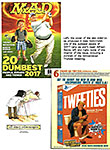
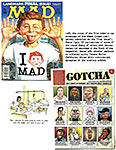

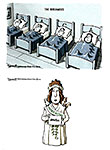

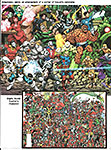


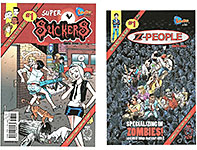
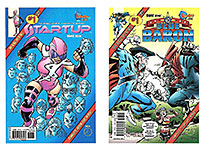
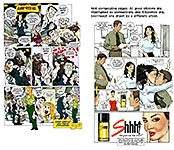
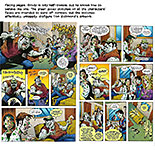
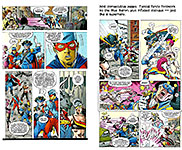
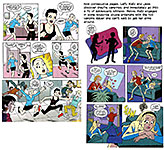
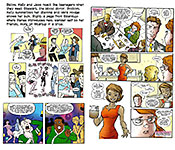
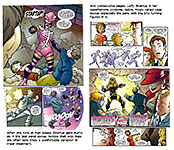
1.jpg)
Stormy1.jpg)
Stormy2.jpg)
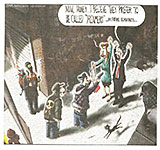
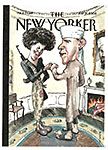
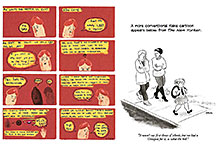
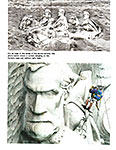
1.jpg)
2.jpg)
3.jpg)
4.jpg)
5.jpg)
6.jpg)
7.jpg)
8.jpg)
